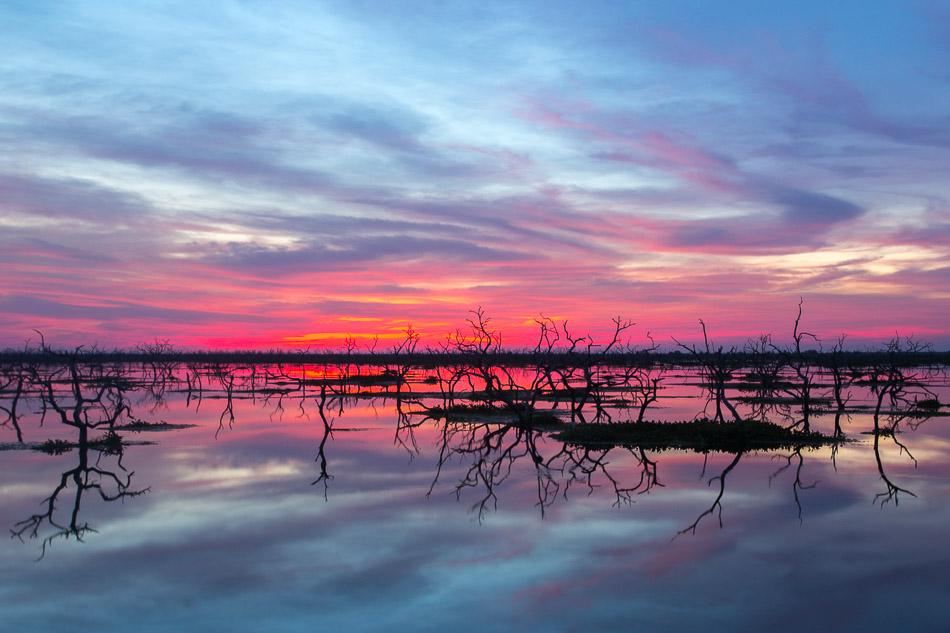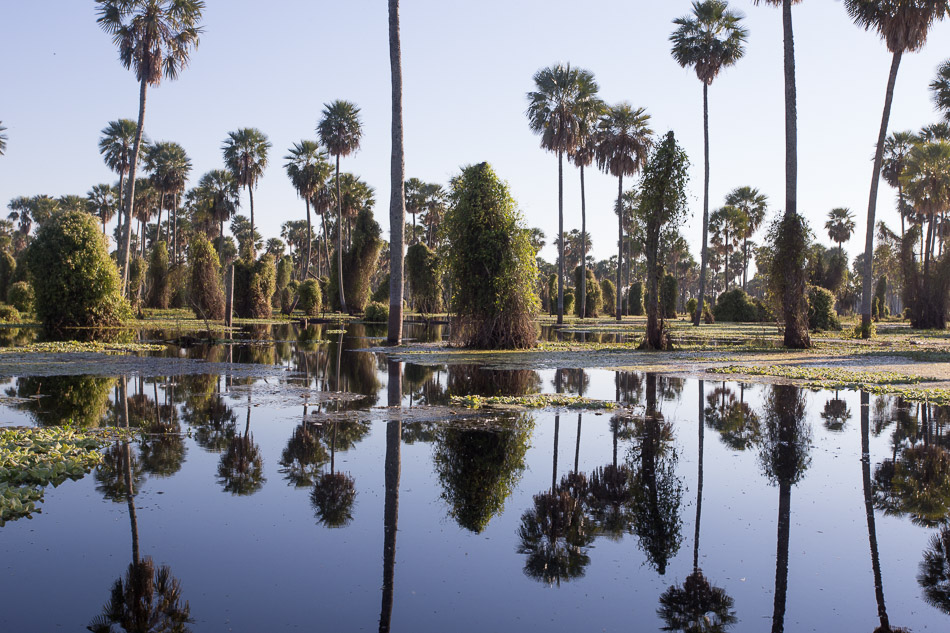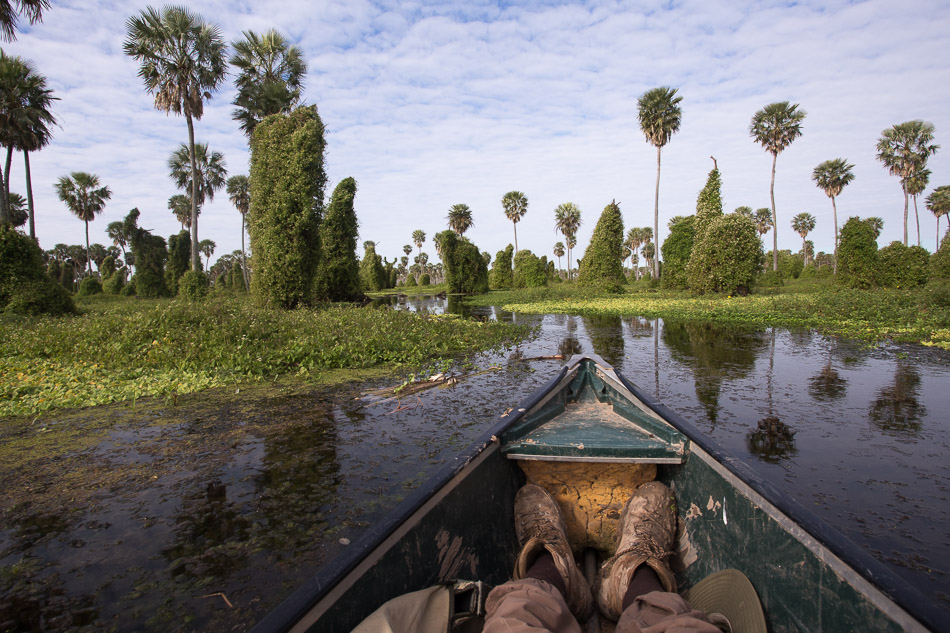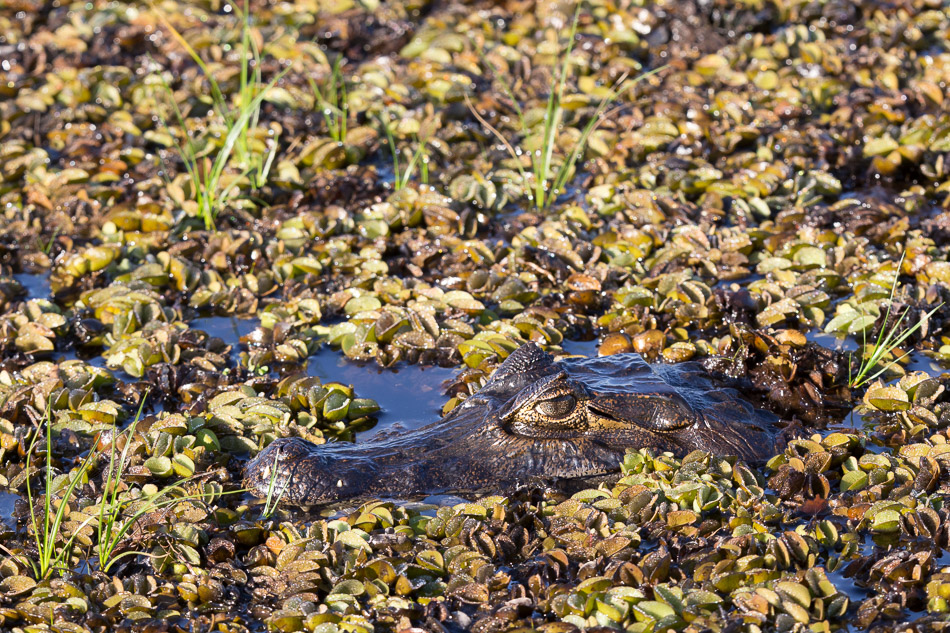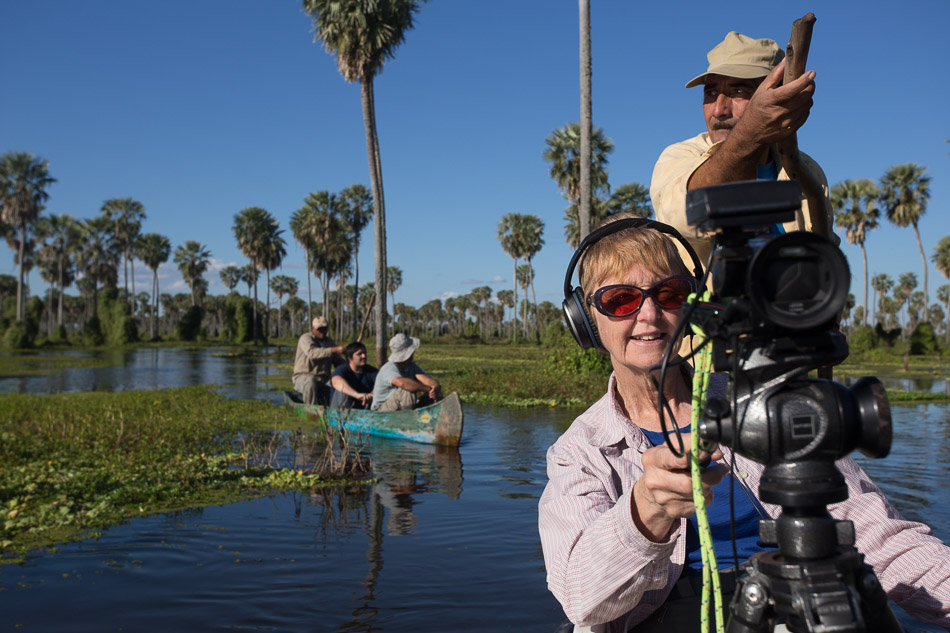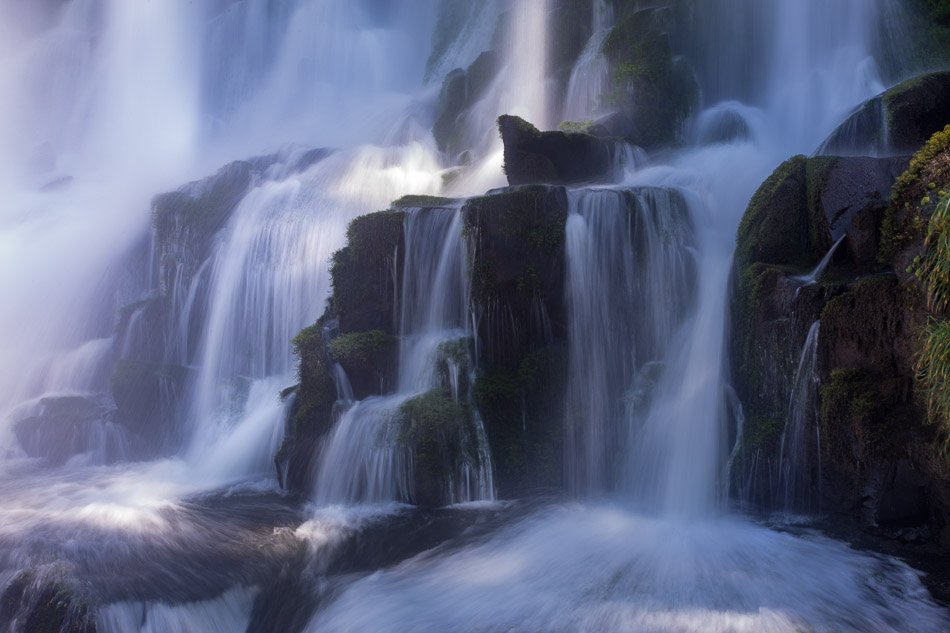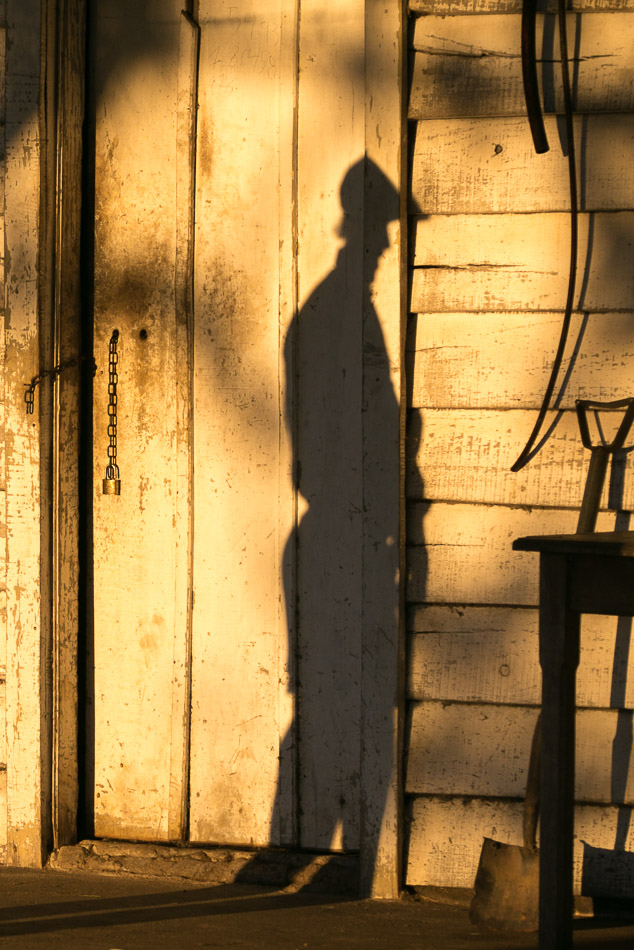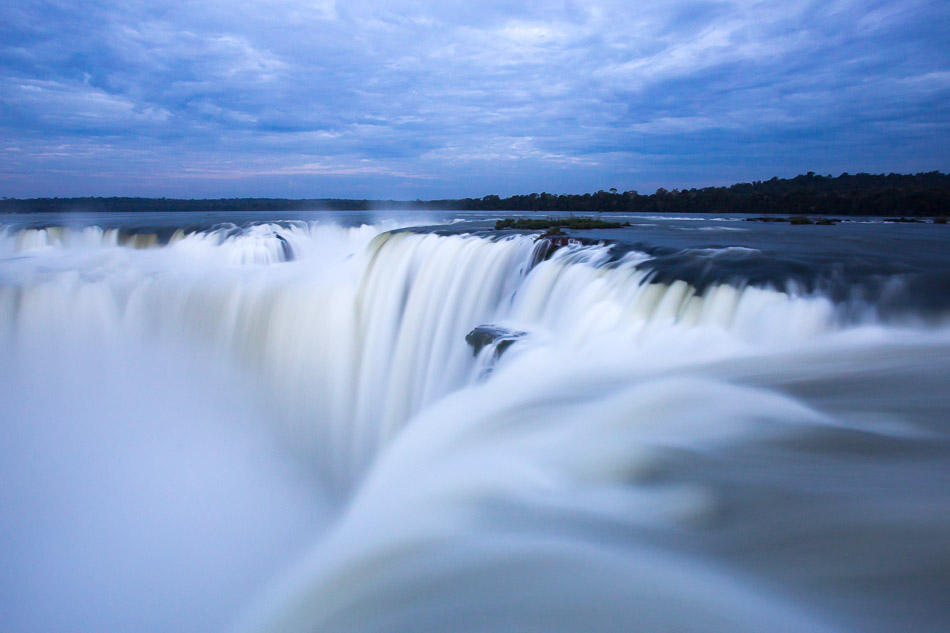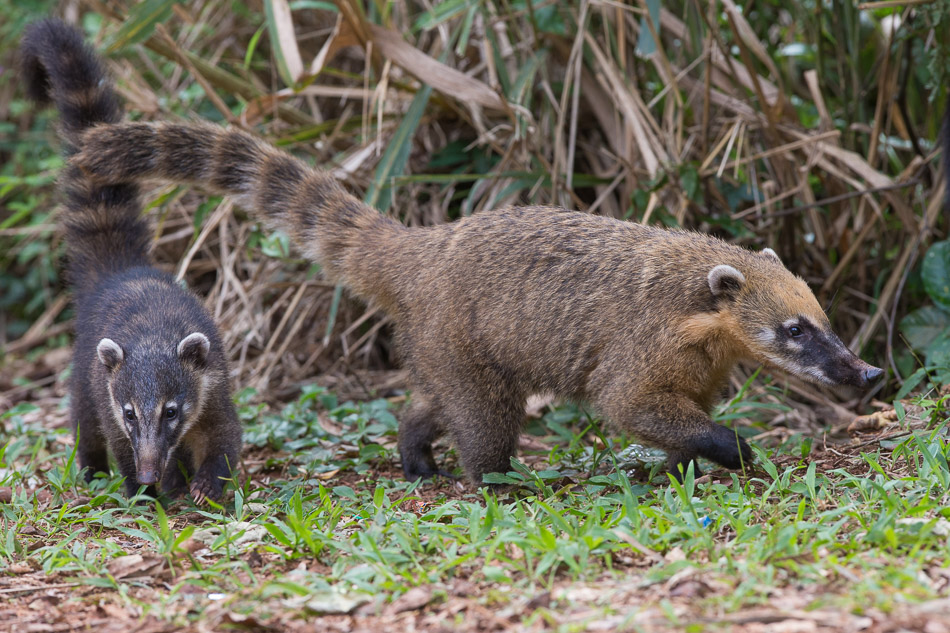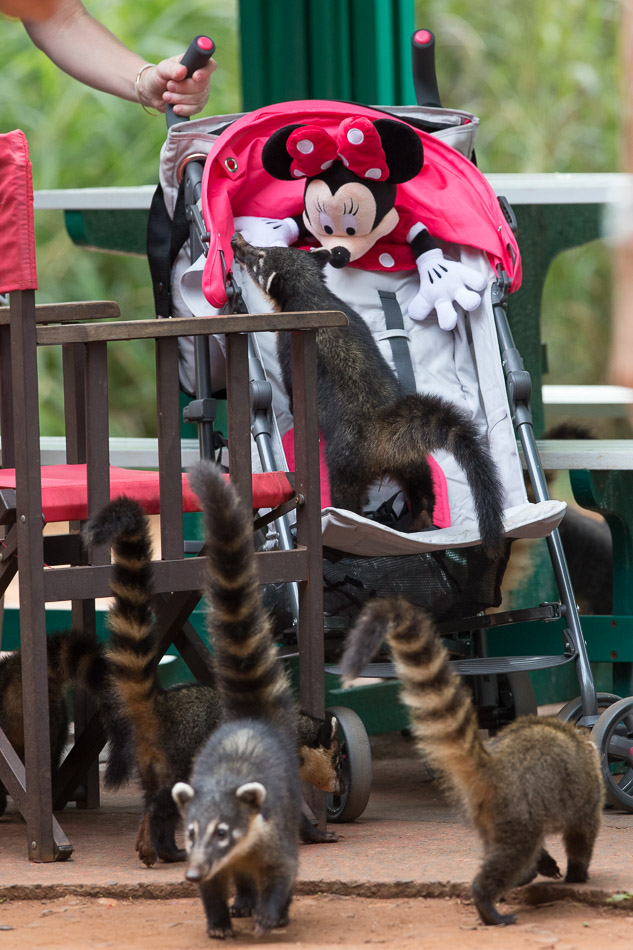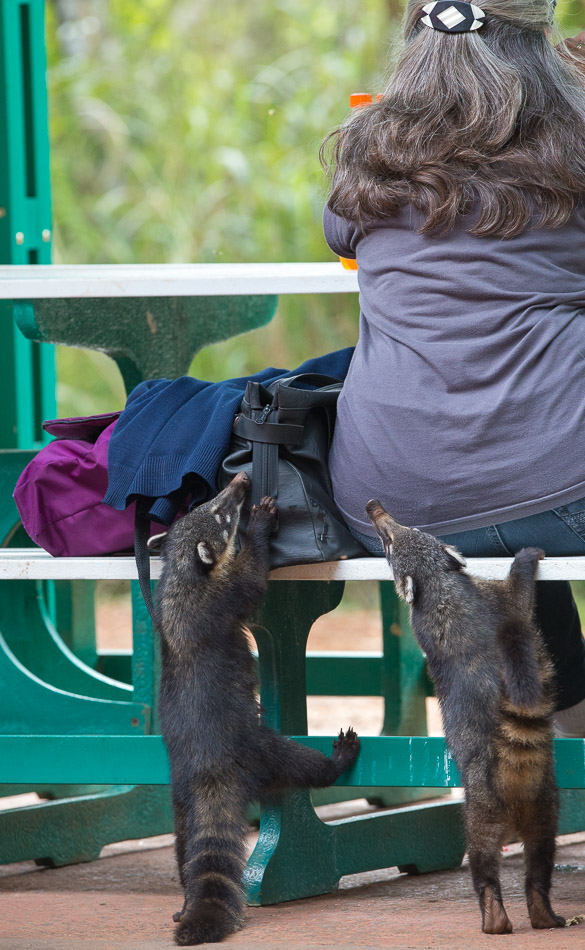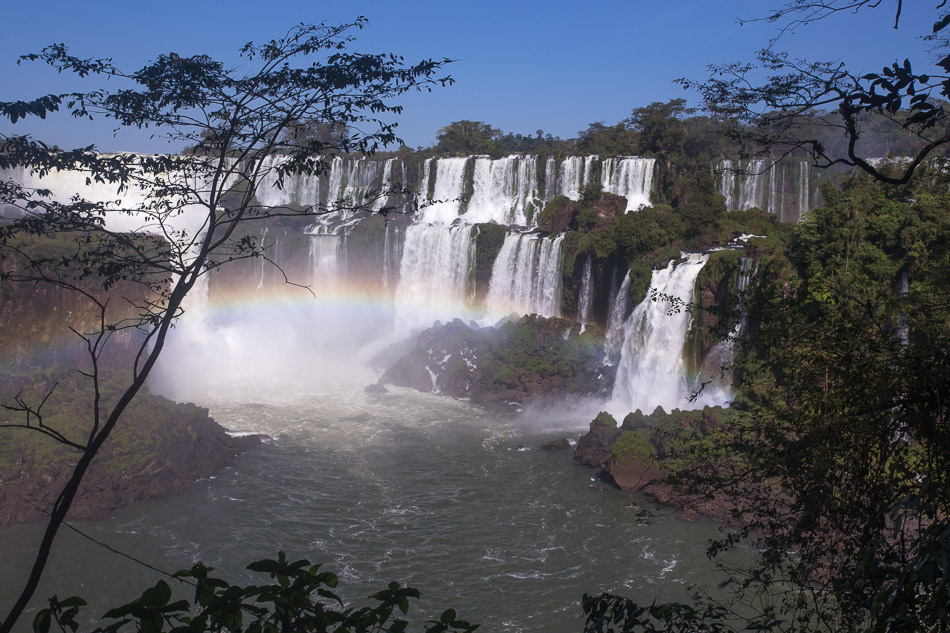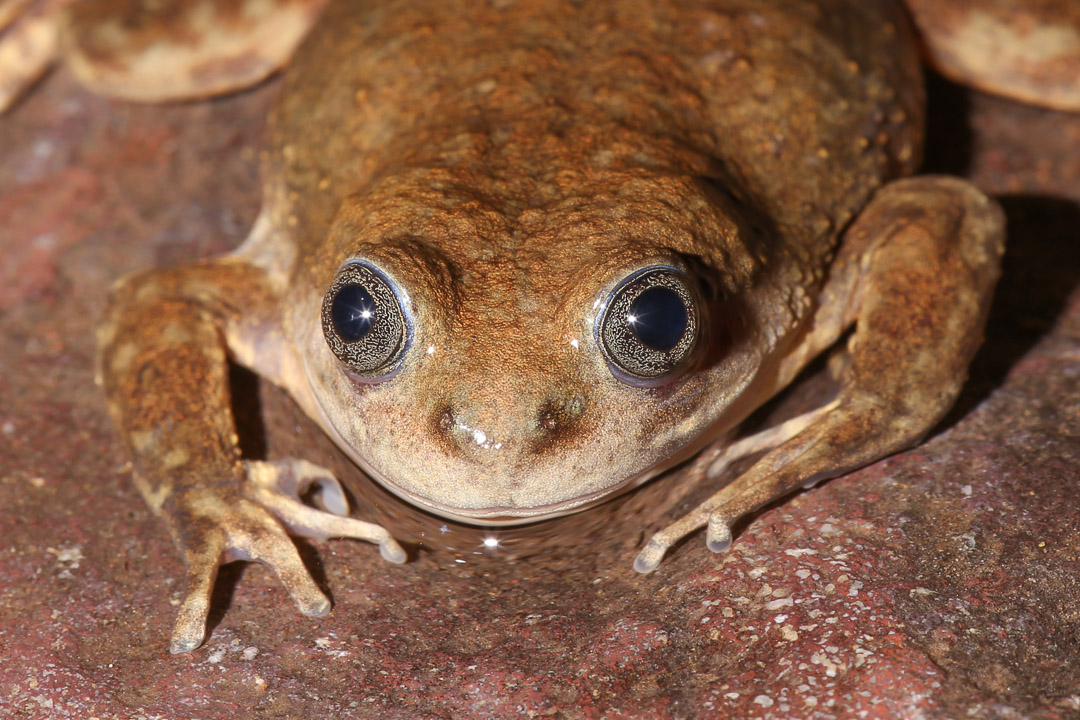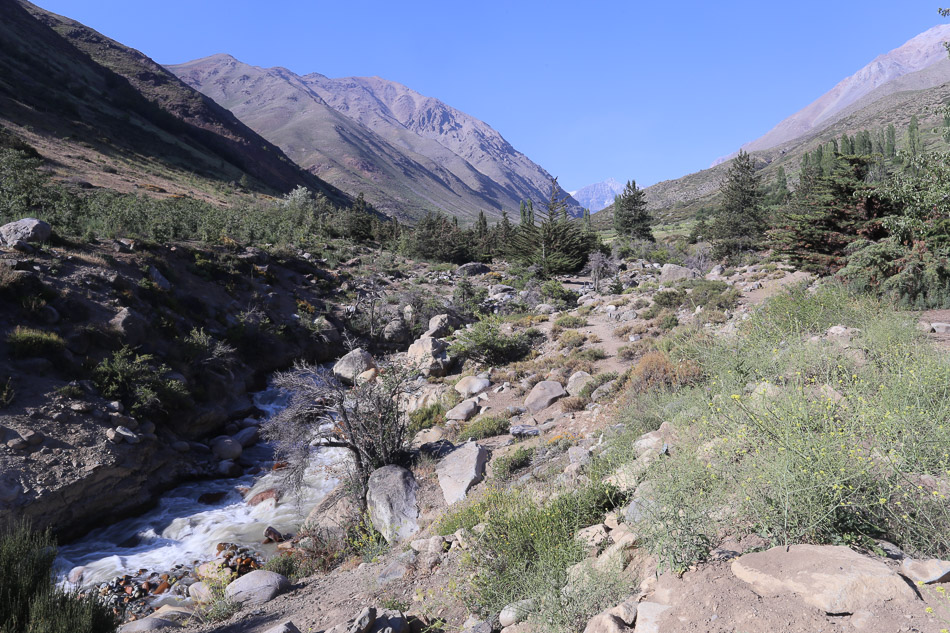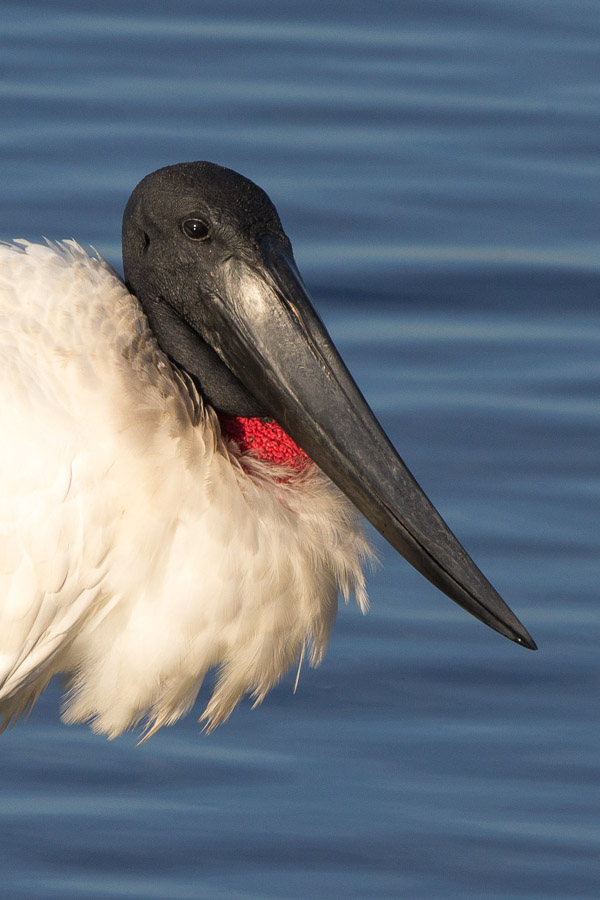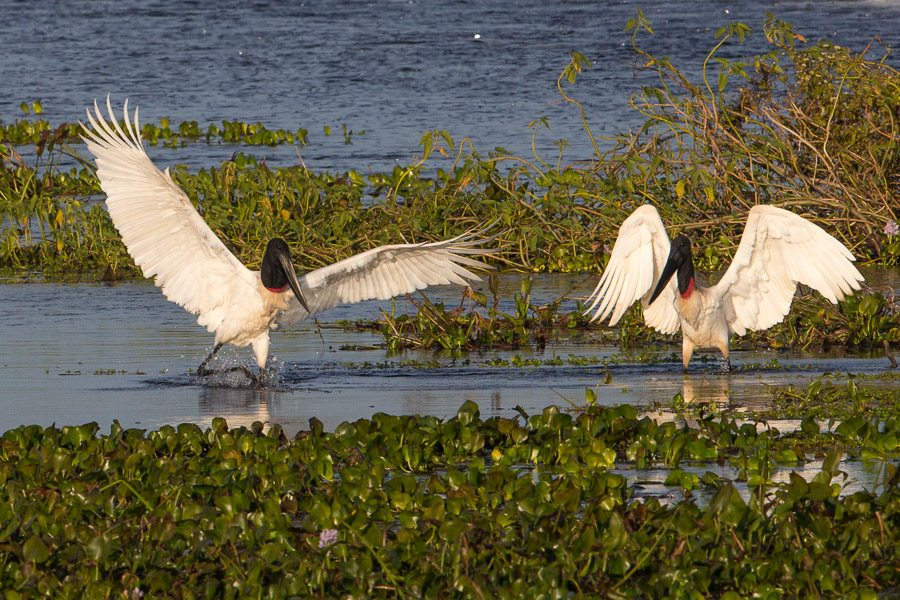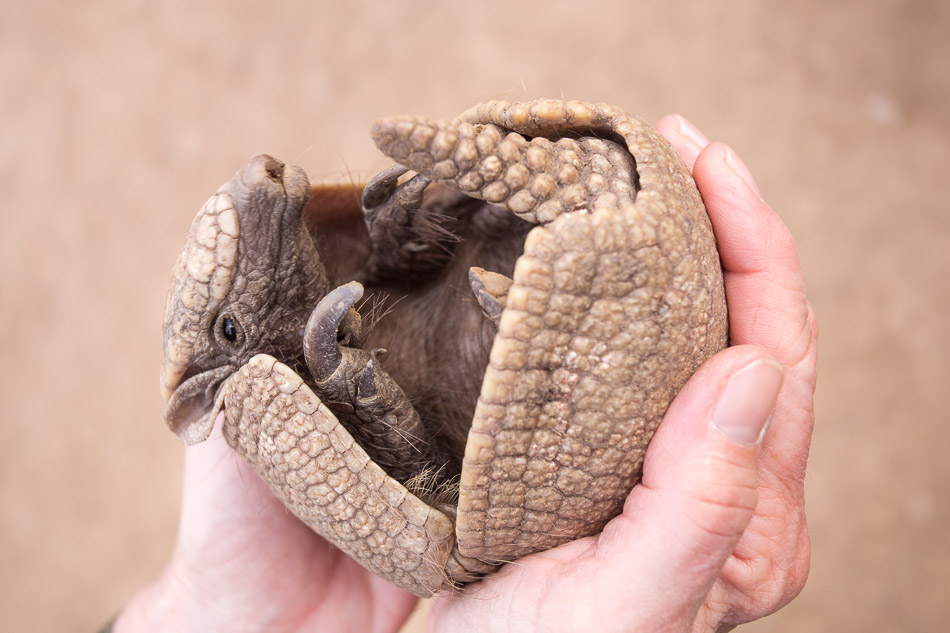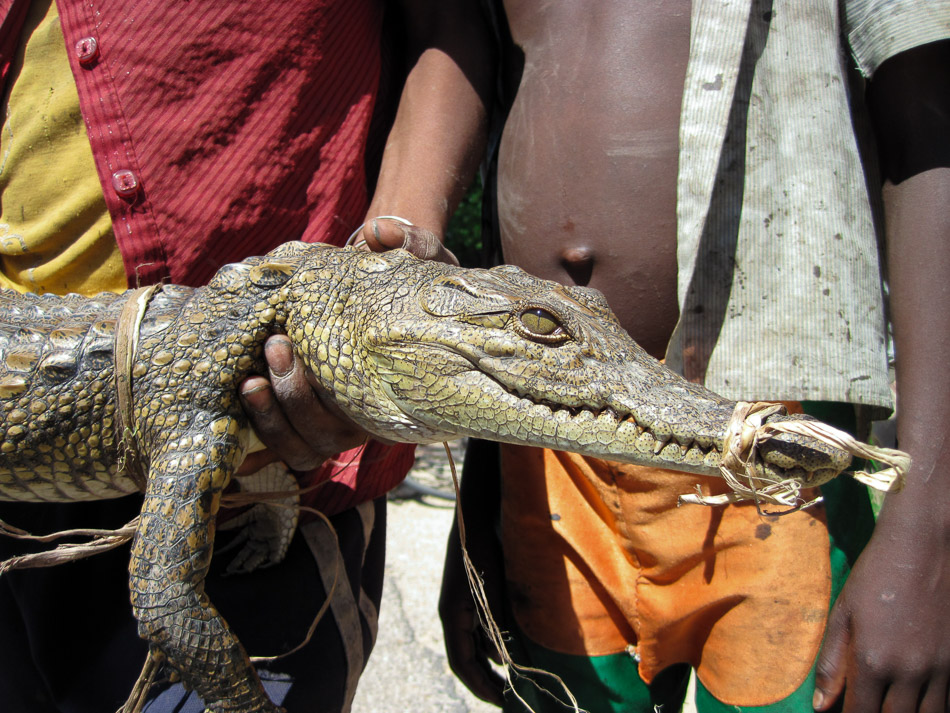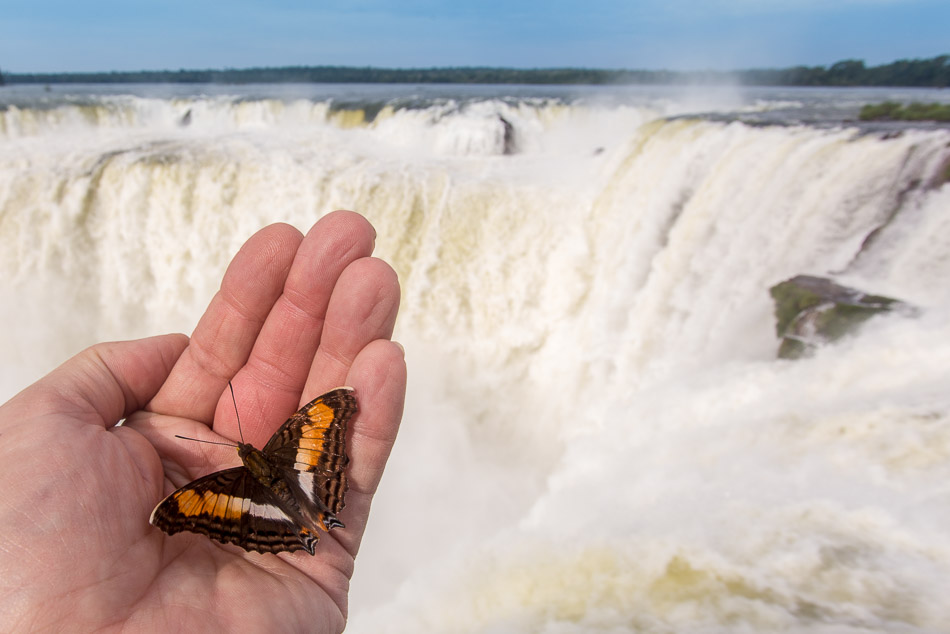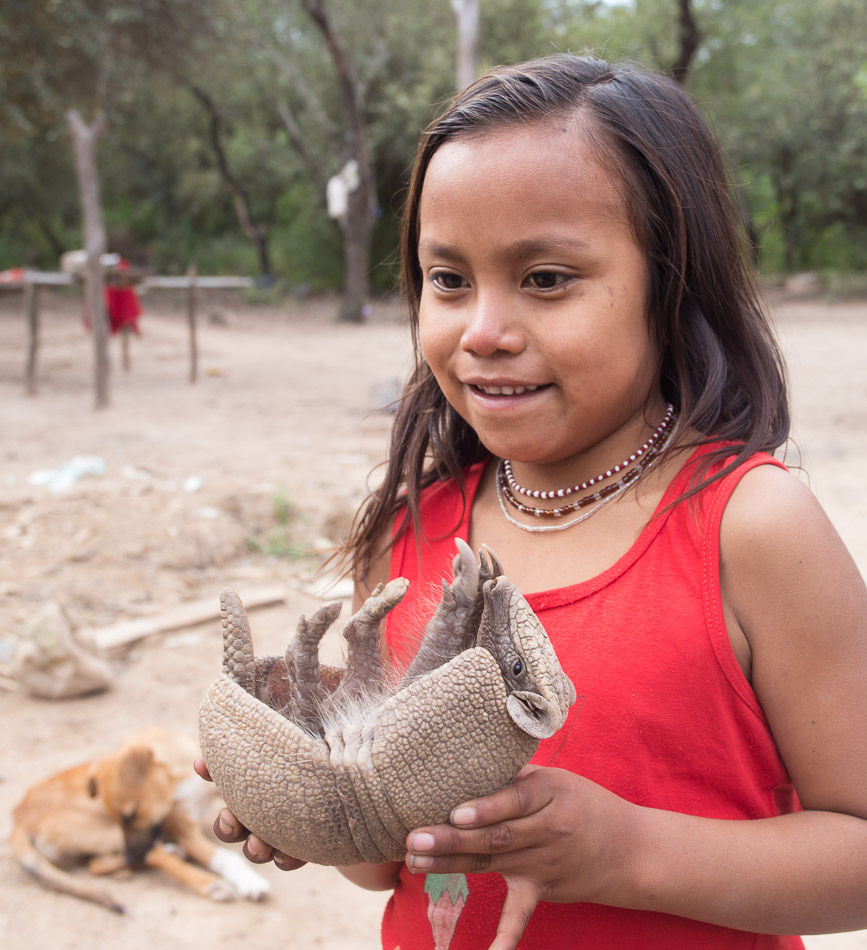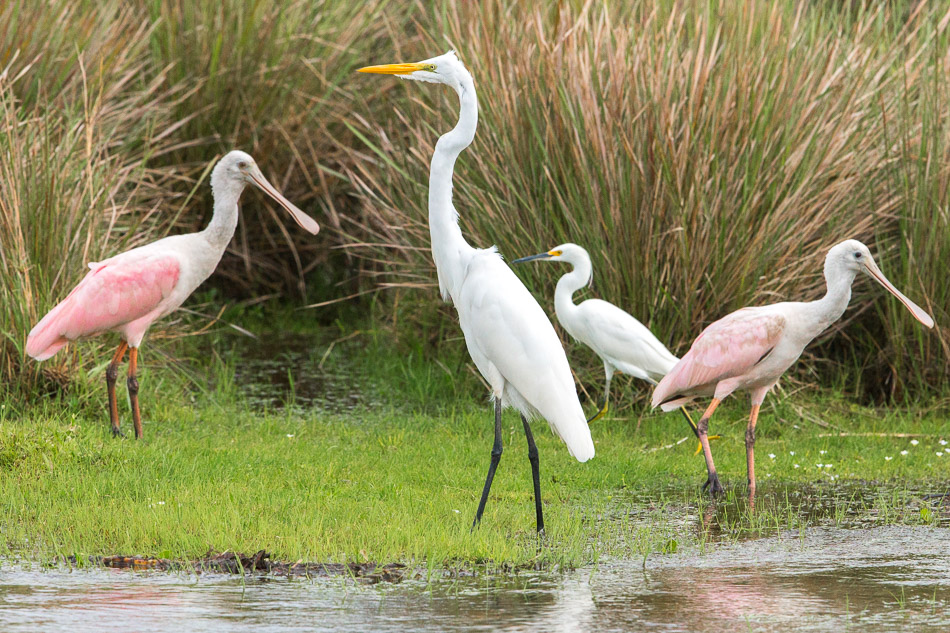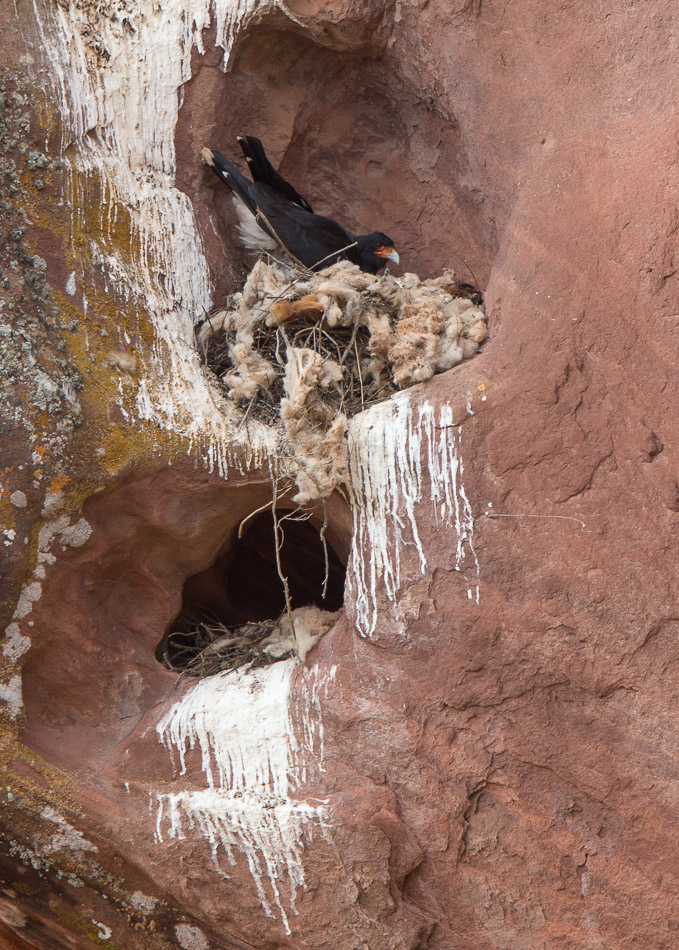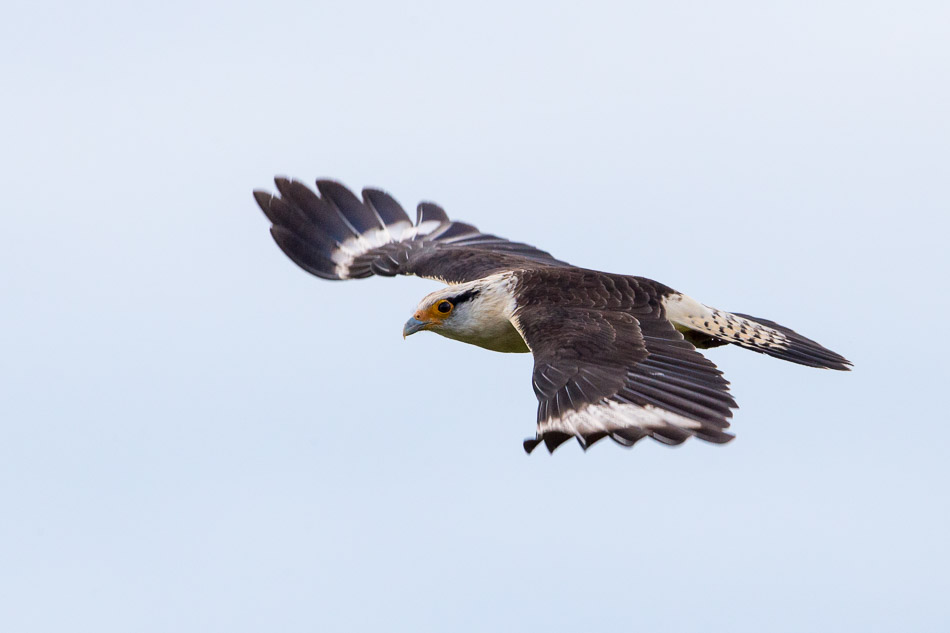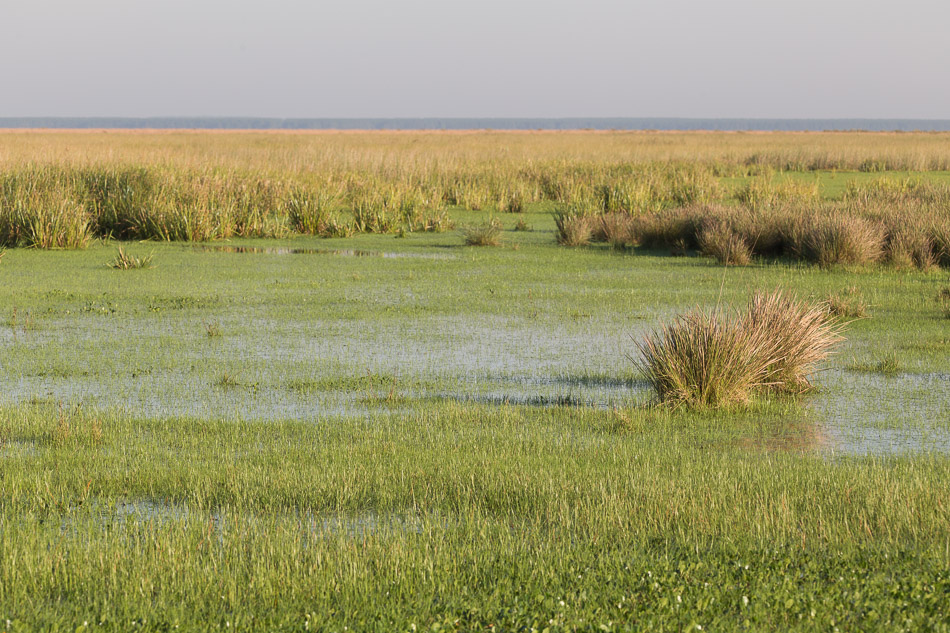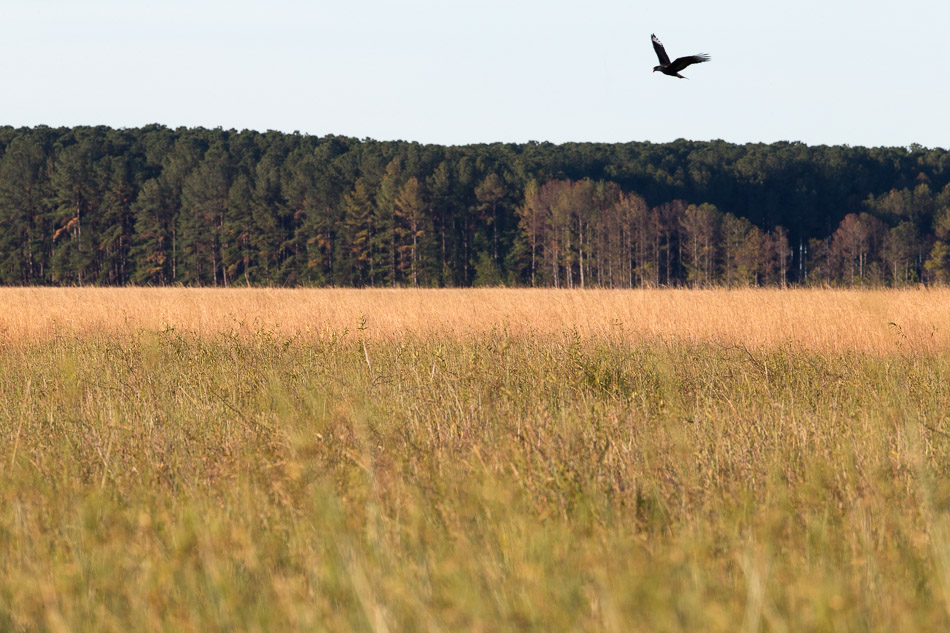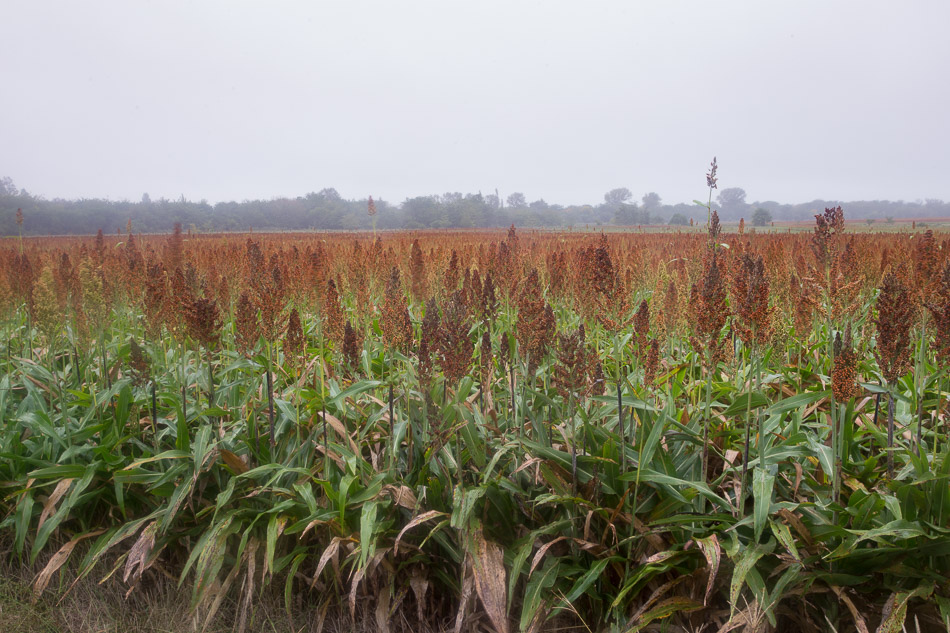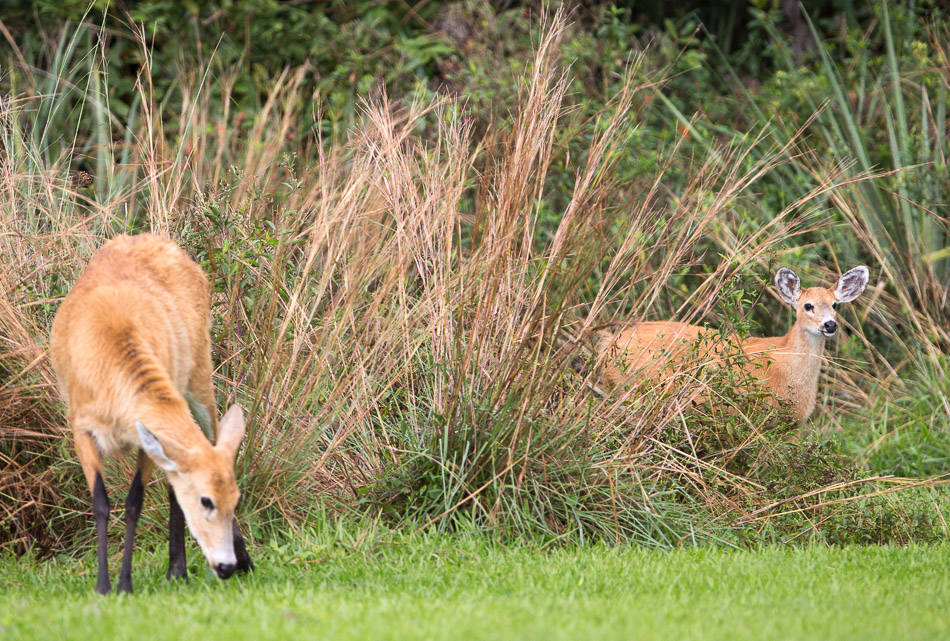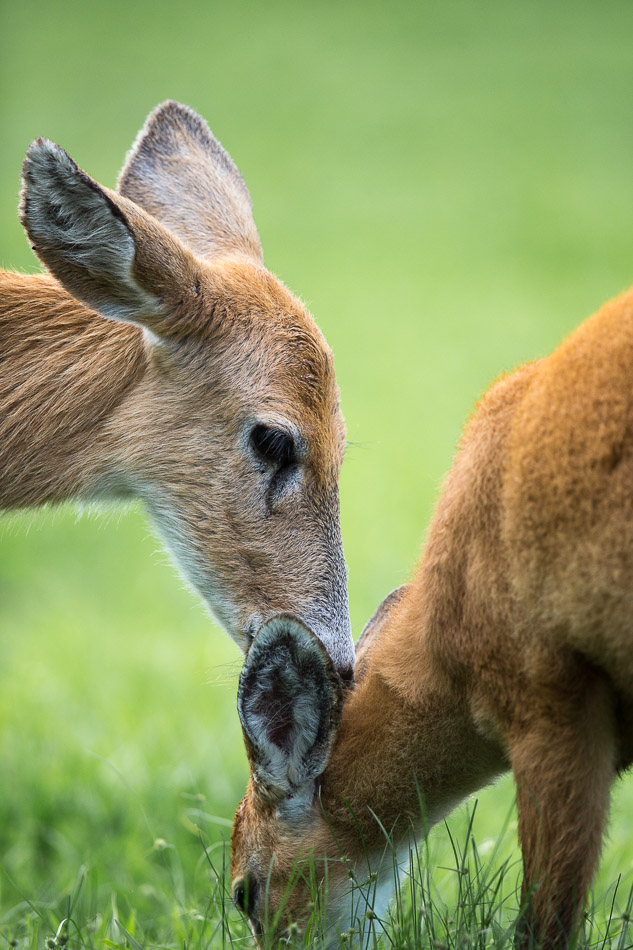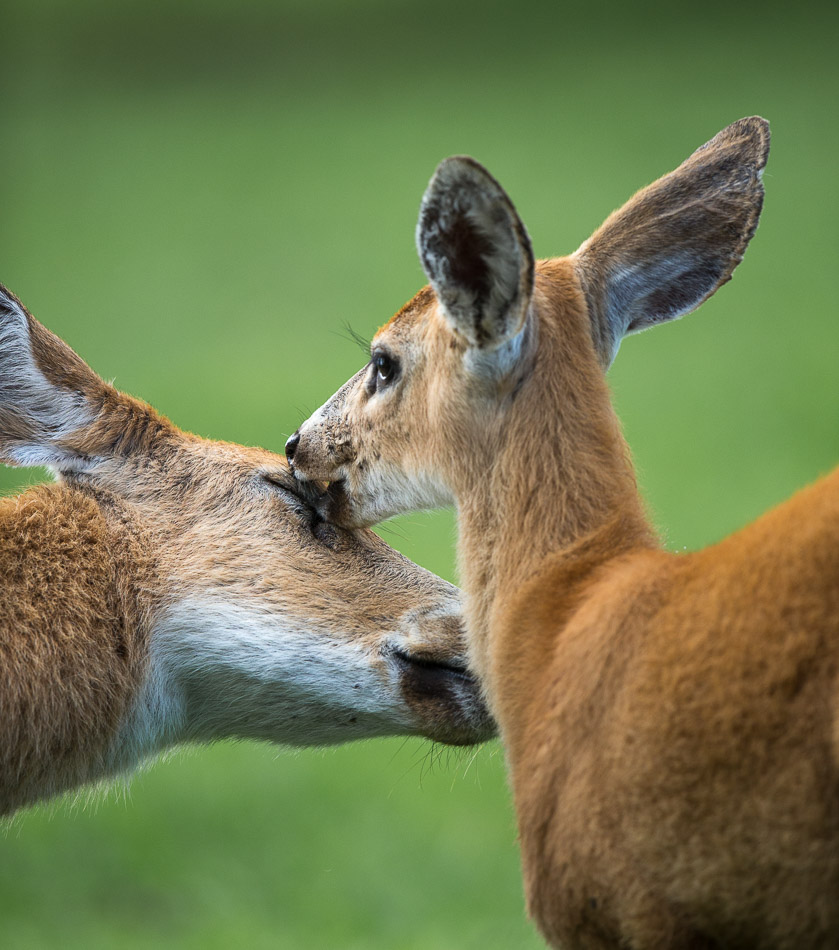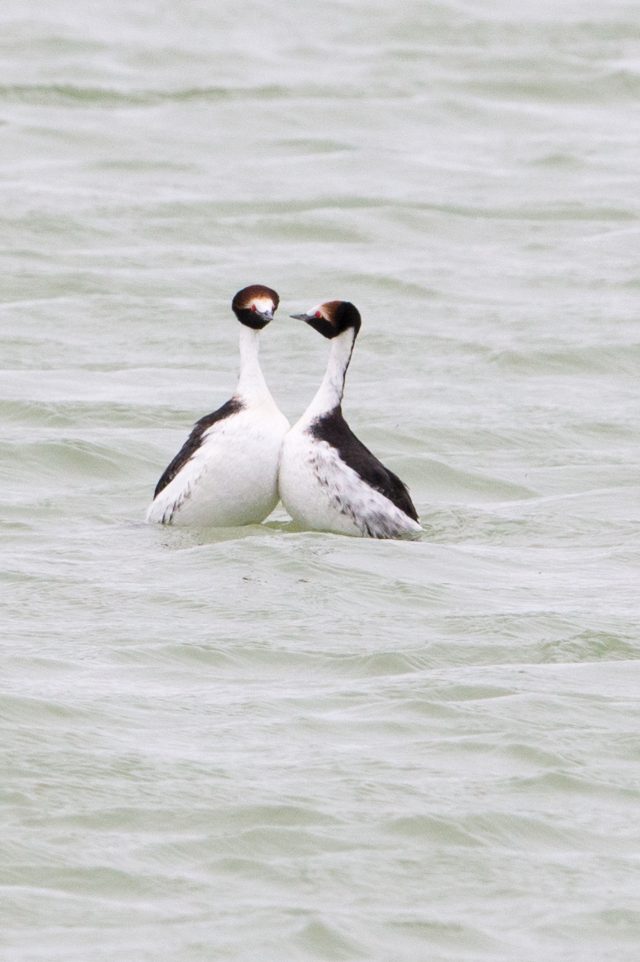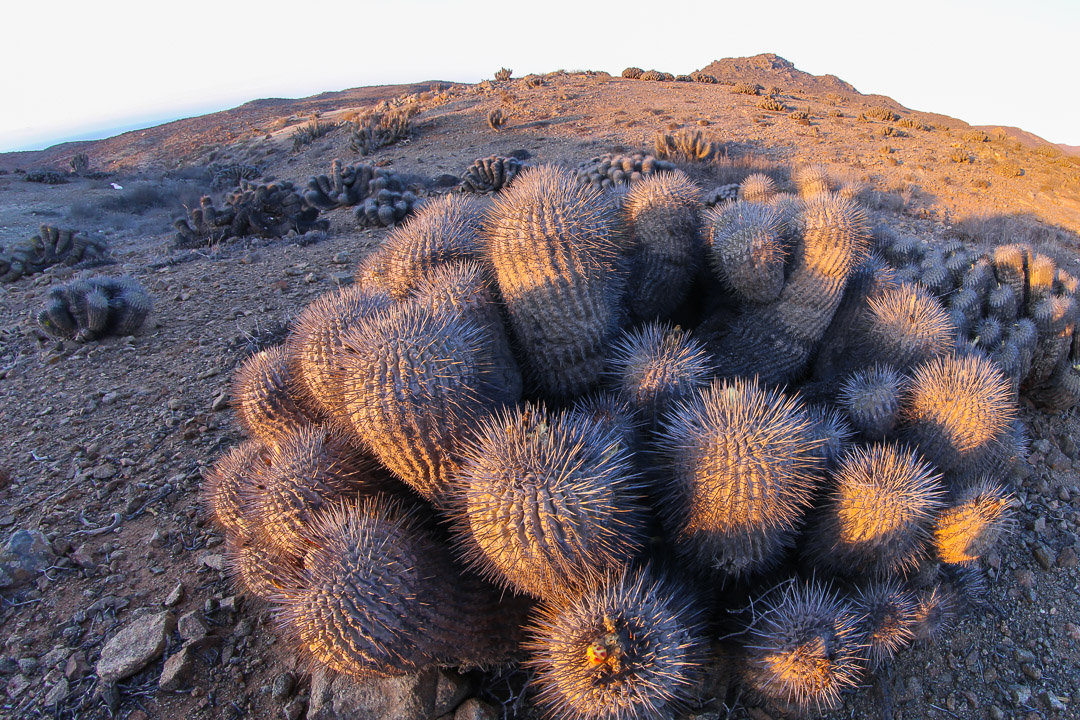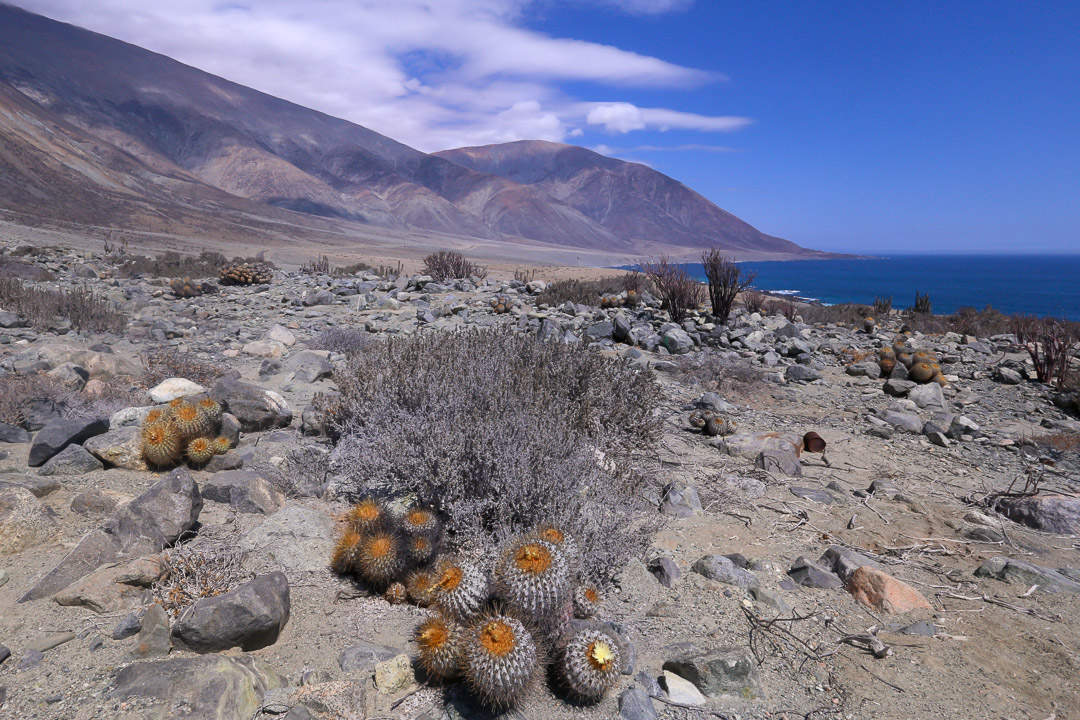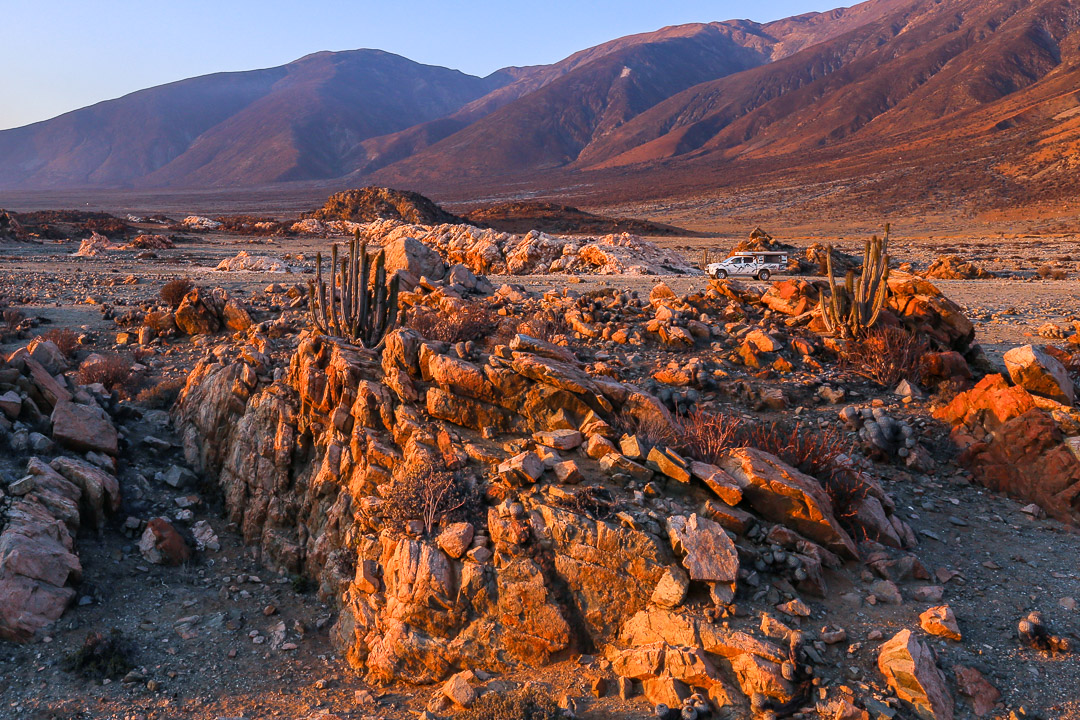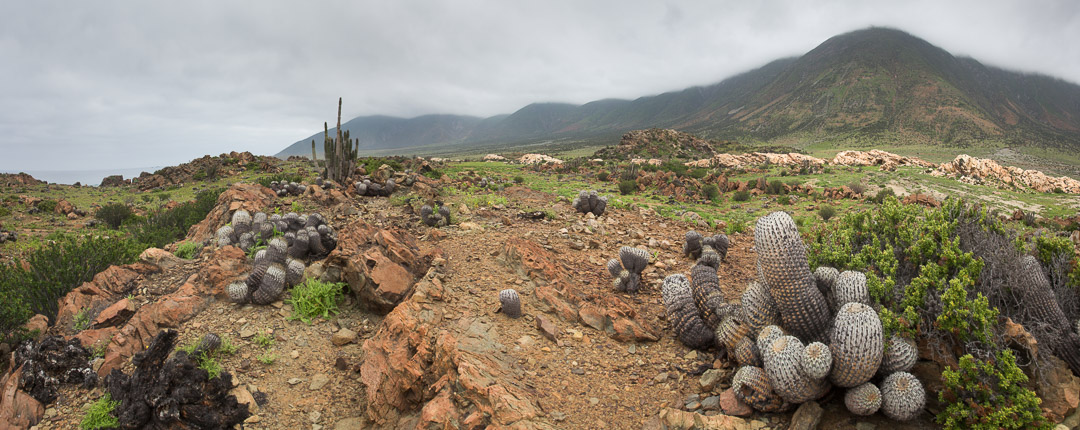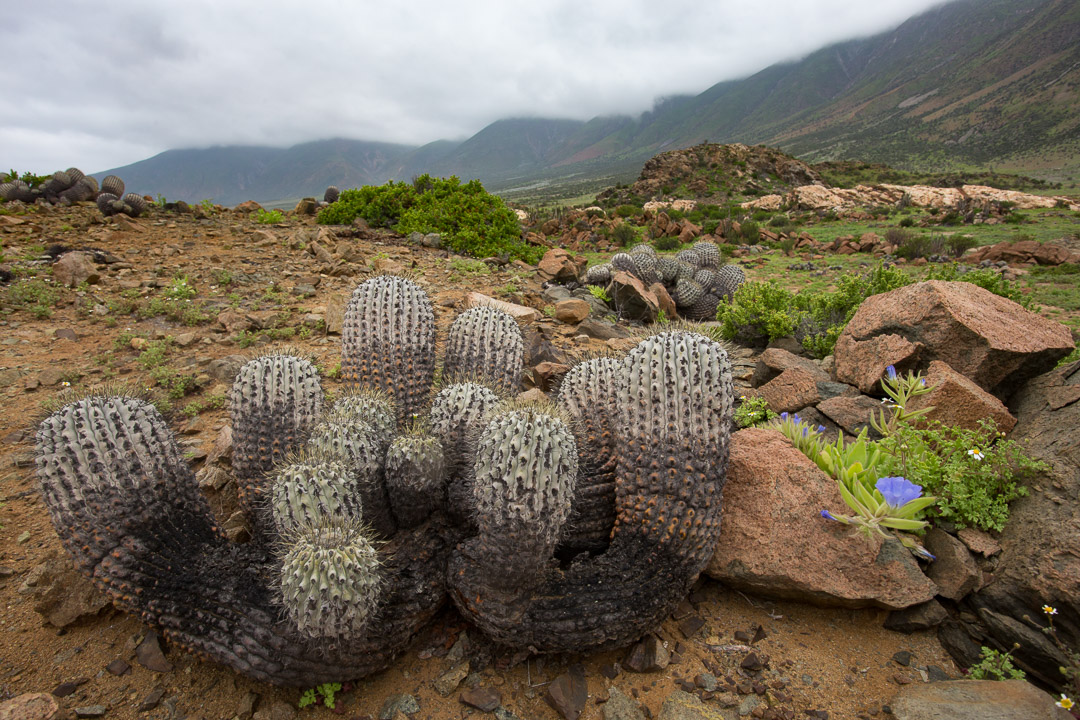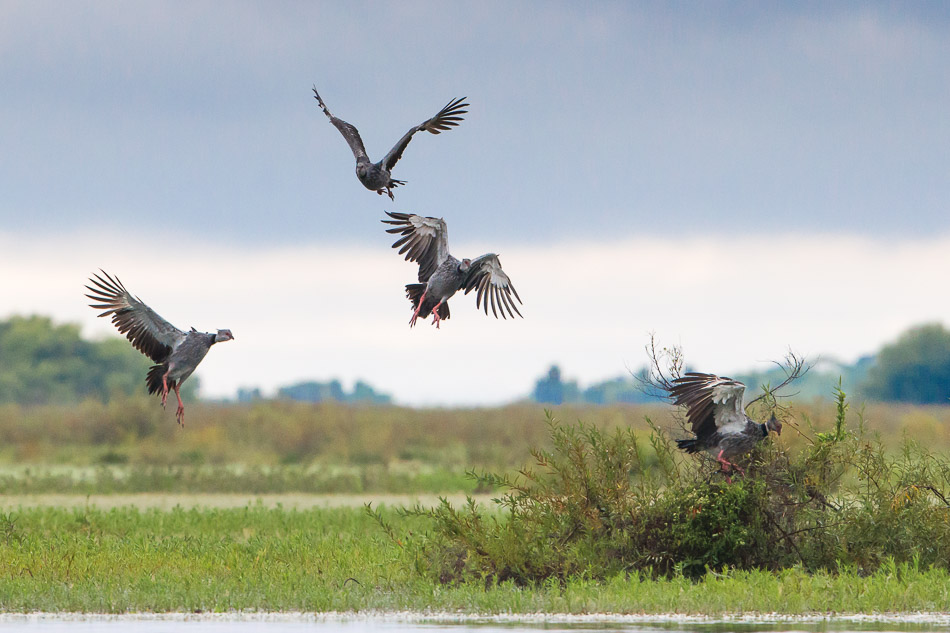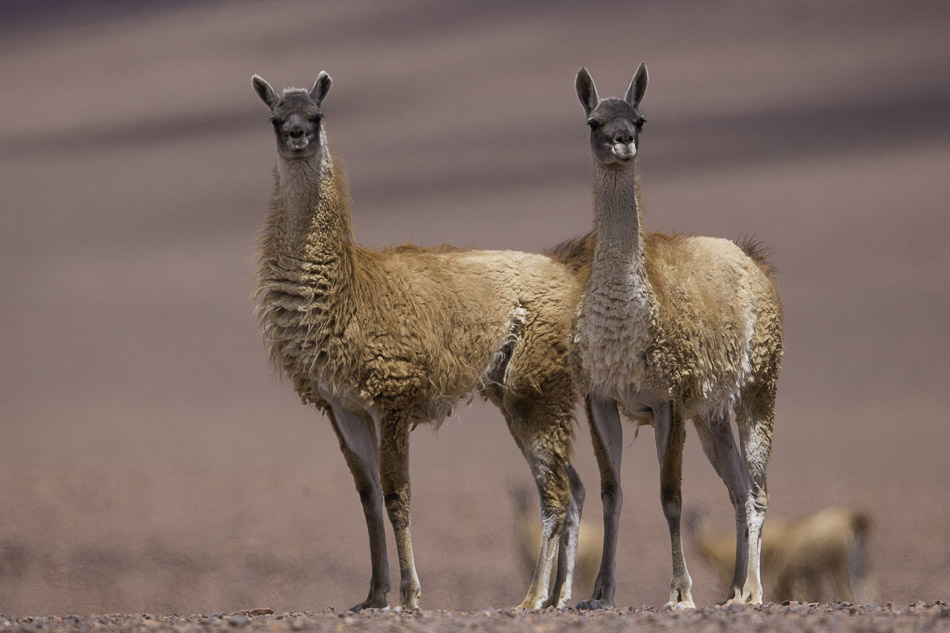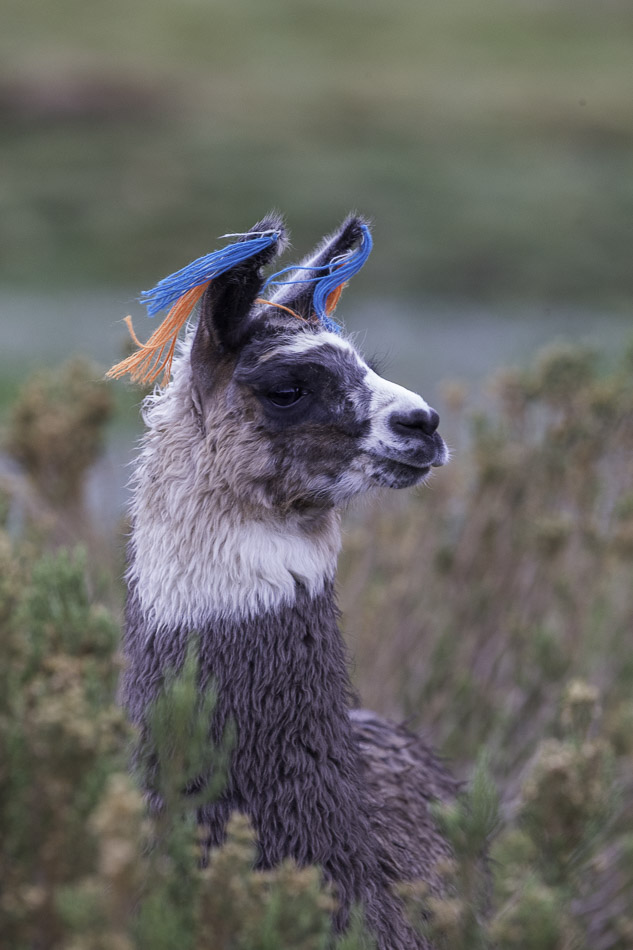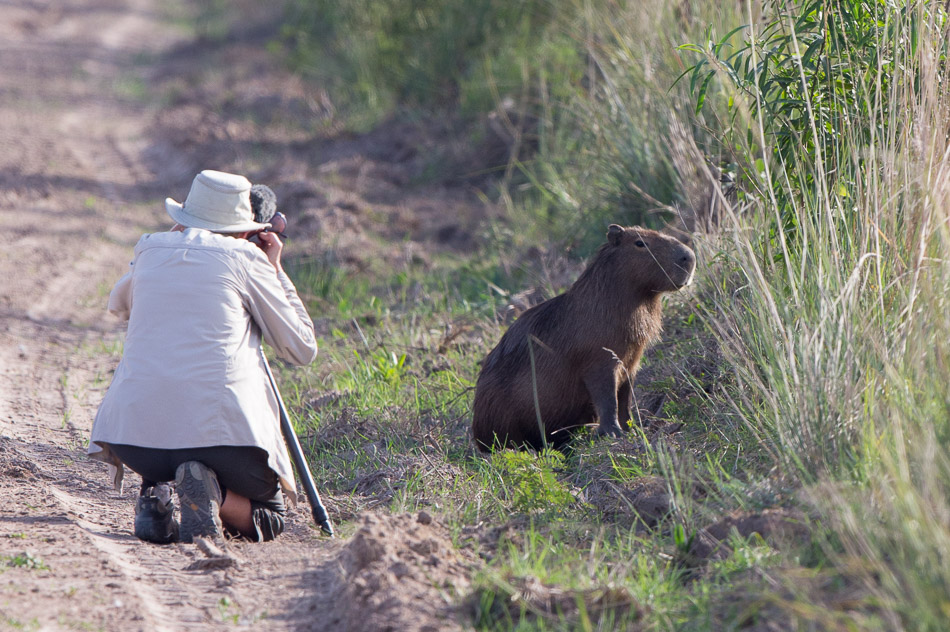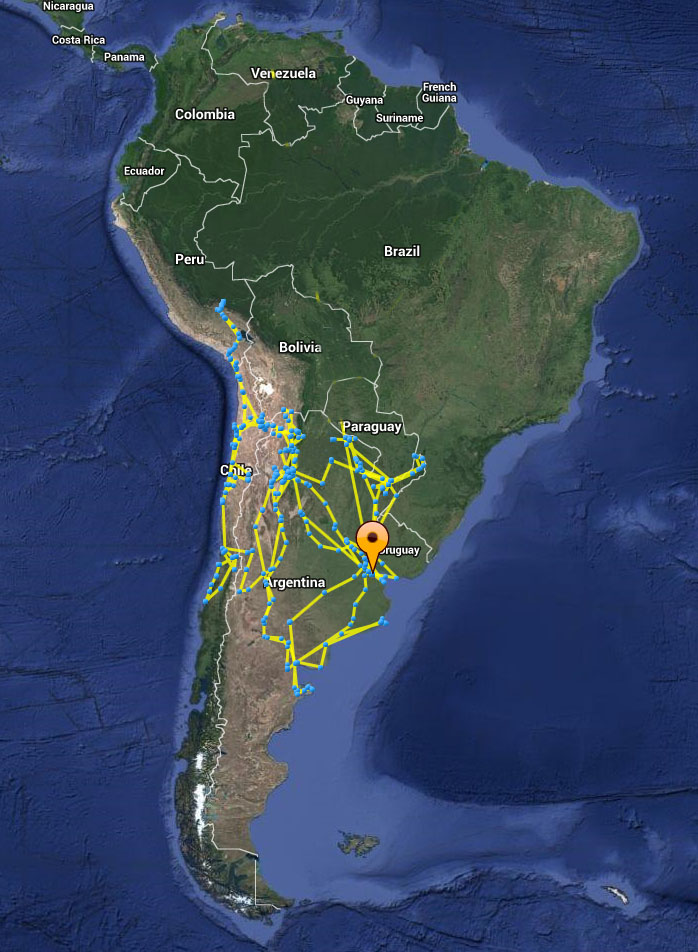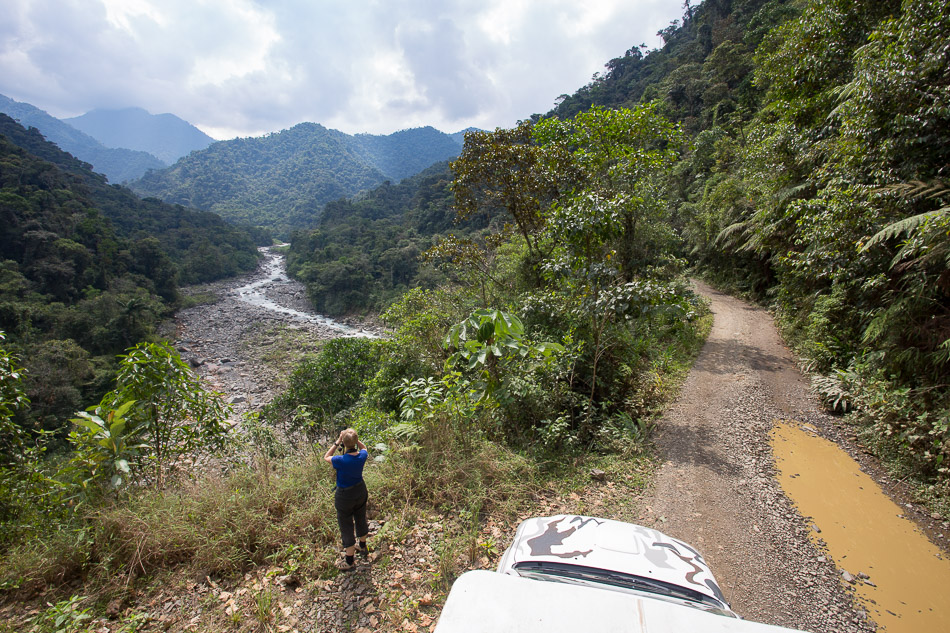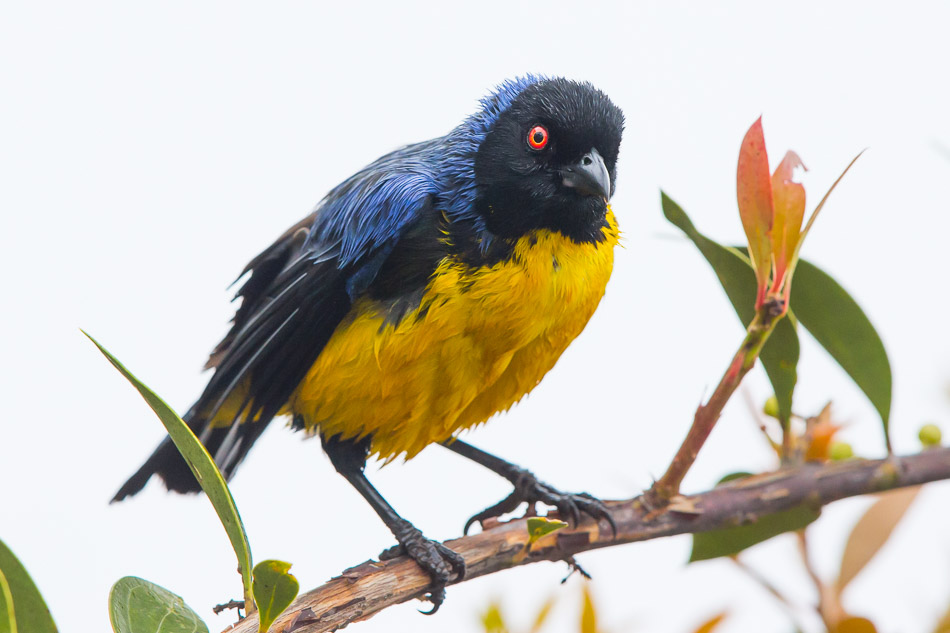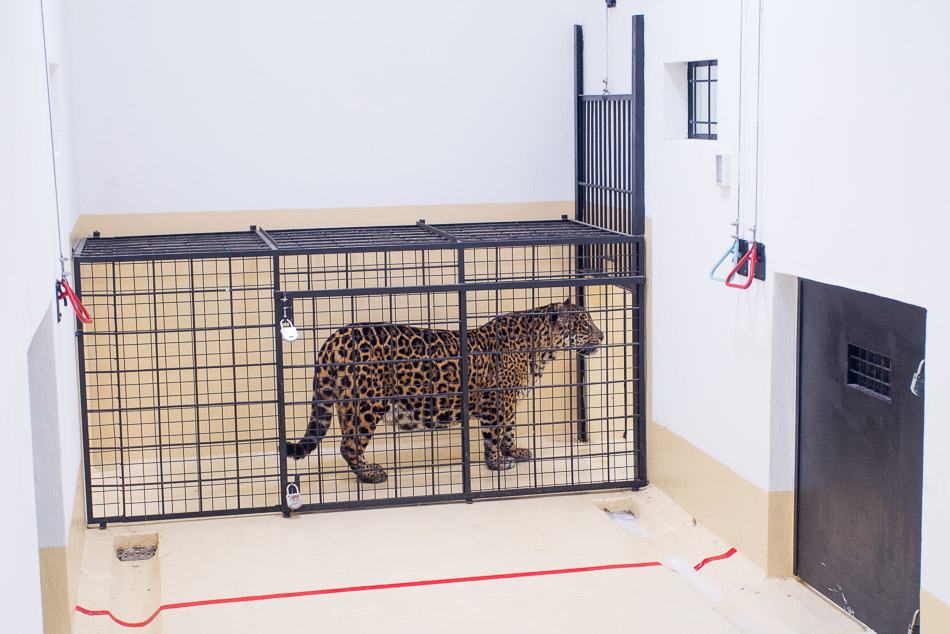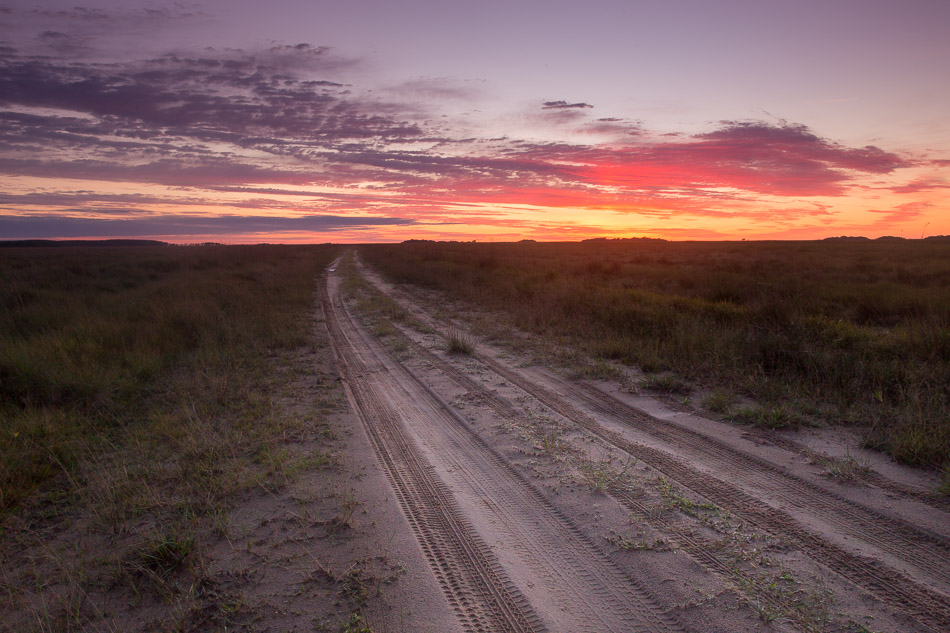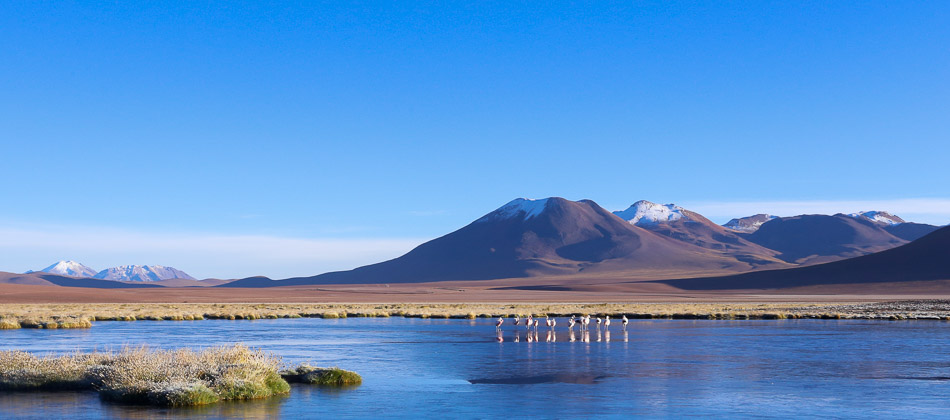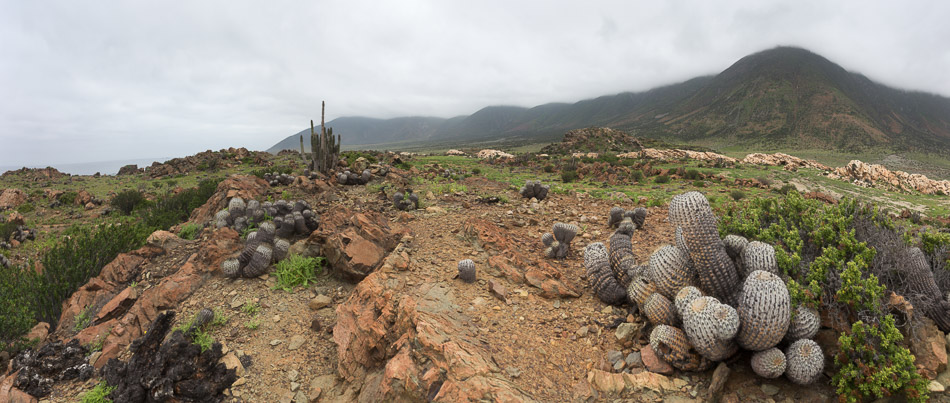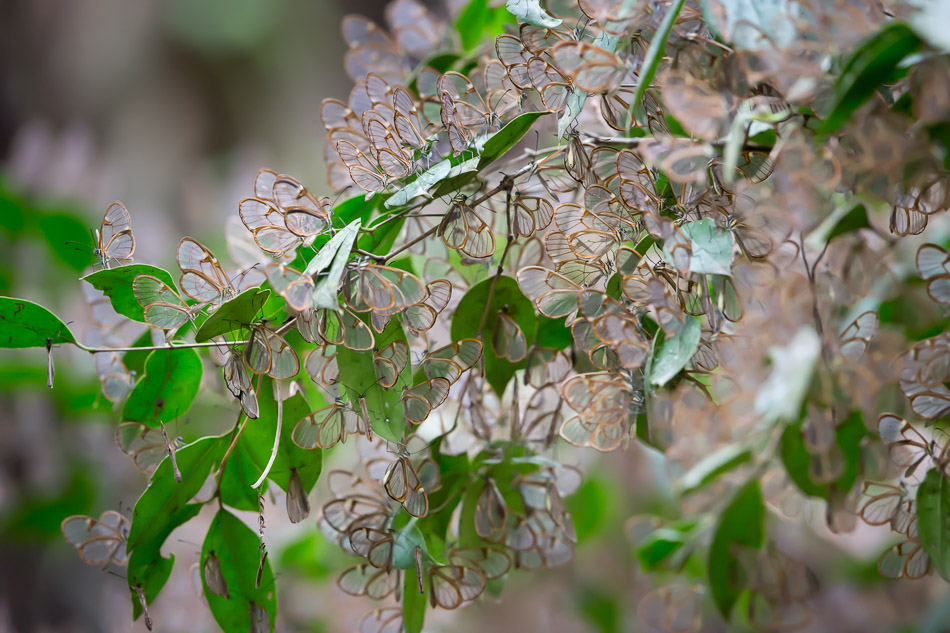Photo Blog
Our journey into Argentina’s flooded forest came about by accident. We intended to go to Paraguay but recent heavy rains had caused serious flooding of rivers and roads and we could not get access into the country.
Instead we headed west and explored the Formosa province in the north of Argentina.
We followed the river Pilcomayo, the boundary between Paraguay and Argentina. The Pilcomayo drains the vast and luxuriant eastern slopes of the Andes in Bolivia. It then flows thousands of miles south east before joining an even greater river, the Paraguay. In the 1920s, the Pilcomayo broke its banks and inundated hundreds of square miles, including a great forest. This is now Argentina’s flooded forest, called the Banado La Estrella.
The new wetland gradually killed most of the Quebracho and other native trees. To-day all that remains of this leafy kingdom are skeletons of bleached timbers thrusting into the sky, an eerie, but hauntingly beautiful forest.
The dead and dying trees have become festooned with climbing water plants making them the ideal hiding places for Yellow Anaconda snakes. The only trees still living are the Palms and even those are now starting to die.
We were able to drive along tortuous muddy tracks to one of the isolated indigenous villages that skirt the wetland and camp close to the village where the following morning a local man took us out in his canoe.
The shallow depth of the water and the profusion of aquatic plant life meant that the man used a long pole to punt us through the myriad of narrow channels.
All around, hungry looking eyes were upon us, long snouts occasionally piercing the surface, Caiman heaven.
Argentina’s flooded forest surrounded us. As the man pushed hard on the pole, the canoe moved through the open channels, the slow pulsing of the boat making it easier for Paula to film the wildlife that we saw.
Newly-weds Pamela and Paul visited the mighty Iguazu waterfalls for their honeymoon, but they didn’t expect honeymoon butterflies.
Neither did they expect to meet Paula and I.

Pamela and Paul were both keen photographers, so we had plenty to talk about.
The Iguazu waterfalls are magnificent, the landscape and the thunderous noise of the water assails every sense.
In such a place it’s not easy to be alert to nature’s smaller creatures, but butterflies are special.
These airborne jewels bedazzle and beguile and Pamela was captivated, these were good ‘Honeymoon Butterflies’.
Butterfles are delicate, fragile and a kaleidoscope of colour, but in nature all things are connected.
Butterflies help pollinate the flowers and trees close to the river. The trees will flourish , protect and cleanse the flowing river and the water is necessary for everyone.
These are the best honeymoon butterflies.
The Gaucho is to be found in Argentina. The Cowboy is to be found in the North American West. Both these characters have permeated the social history of the regions and both are surrounded in mythology which perpetuates their existence.
As we drive the tracks and trails through Argentina, we meet up with Gauchos in the most remote areas. Often driving cattle or horses, the Gaucho is rarely alone, travelling together is safer in the wide open parries and they are usually accompanied by dogs.
The Gaucho arose to hunt and capture the huge herds of horses and cattle that roamed the plains of the pampas.
The Gauchos of the Chaco region have to contend with dense thorny scrub so they and their horses are heavily protected with thick leathery hides.
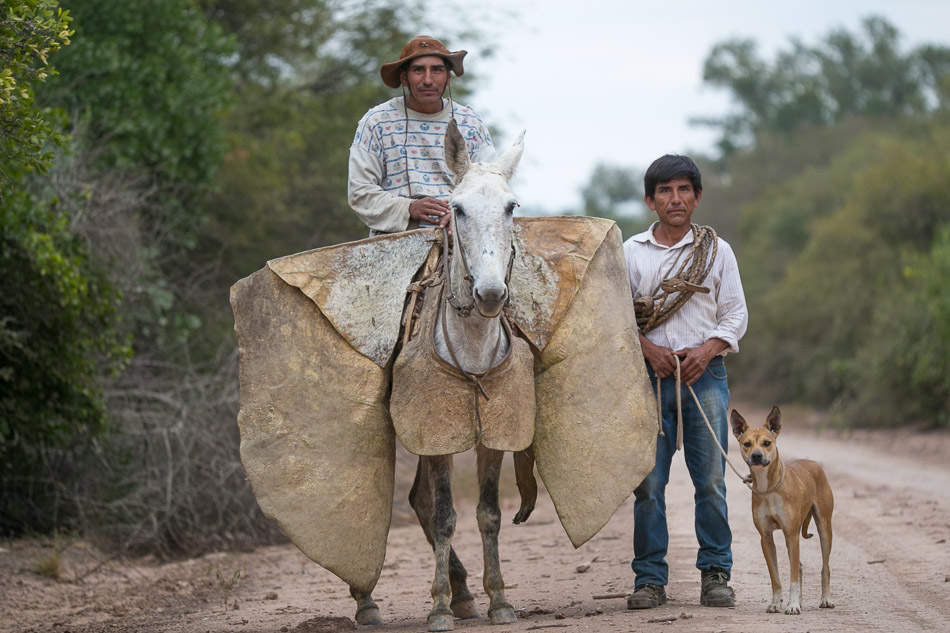
Originally of mixed European and Indian ancestry the Gauchos were know as mestizos.
Tools of their trade always included a knife and a steel sharpener tucked into their wide leather belt.

In the 21st century modern industrialized cattle rearing means the once extensive estancias now require people who understand computers, DNA blood-lines and genetics, not the bolas and lasso.
The Gauchos life on the windswept plains, rounding-up and driving cattle, of night-time fires and drinking mate is coming to a close. The Gaucho will soon be a shadow.
The thieves of Iguazu lie in wait for people who visit the wonderful waterfalls that straddle the border of Argentina and Brazil.
The thieves of Iguazu are furry and cute looking, they are Coatis and they are thieves.
Their ploy is wait, concealed in the undergrowth around the visitor trails, until they see a group of people. When the people are close, a couple of animals will appear and often the visitors are delighted to see them, children ‘coo‘ and adults ‘ahh‘.
Close to restaurants, cafes and sitting areas, the visitors may get from their bags some food or buy a drink and a snack at the cafe and that’s what the thieves of Iguazu have been waiting for, they pounce.
With the sounds from the rustling of paper or the opening of a bag, the Coatis rush from their concealment. Ten or more of the animals will surround the people, inspecting bags, jumping onto the backs of chairs or the tops of tables, even climbing onto prams. The Coatis are after food and they are crafty thieves.
So, if you visit the Iguazu waterfalls, which are absolutely, stunningly beautiful, please no not feed and animals.
If you have children do not allow them to walk around with Ice creams or a bag of sweets as the Coatis will try to steal it.
That way you will enjoy your visit to one of the great natural wonders of the World.
Large soft eyes make a female blush.
But for frogs they are not intended to.
They need them as they don’t have flexible necks and as their eyes protrude, giving them almost 360 degree vision, so the eyes seem huge compared to the size of the animal.
Don’t underestimate frogs, they can see in colour and can see the smallest of movements.
This frog is called Alsodes montanus and lives in the fresh unpolluted streams flowing down the western slopes of the Andes, where the surrounding vegetation is Mediterranean scrub.
The ‘Living Wild in South America’ expedition into Chile found the frog, an example of the rare wildlife to be found in the central part of the country.
Unfortunately the species is threatened. Central Chile is where the majority of the population live and many streams are polluted.
South Americas second biggest bird in is the Jabiru, a huge stork like bird.
They are a common wetland bird in the Pantanal, which is where most birdwatchers see them in South America.
Paula and I have seen them in a number of locations in Northern Argentina but nowhere more numerous than in the Banado La Estrella in Northern Formosa province.
Banado La Estrella is a vast marshland which has seasonal inundations when the river Pilcomajo bursts its banks. During the very hot summer the water dries out and its at those times that many fish lie stranded and die.
That’s the time when the Jabiru clean up the thousands of rotting fish, doing a great job of ridding the environment of harmful bacteria and the potential for disease.
We really do have the World in our hands.
Mankind can do almost anything.
and an individual can do almost everything he or she puts their mind to.
We have the World in our hands, so in this New Year of 2017 let’s all try to be a little kinder to the planet, both the people who live on it and the wildlife that we unfairly share our space with.
We have the World in our hands so this New Year lets care for the well being of our children and teach them to love and understand.
For
“In the end we will conserve only what we will love,
we will only love what we understand,
and we will understand only what we are taught”
A Very Happy and Peaceful Year Ahead
Would you like an Armadillo for Christmas? Yesterday we were driving close by an indigenous village in the Formosa province of Argentina and noticed a little girl holding a baby Armadillo in her hands, she was very happy.
We stopped and asked her how and why she had the baby armadillo.
She said she and a friend had found two of the animals hiding under a bush and had brought them home to play with for Christmas. They were keeping them in a little pen on the ground, but said that the animals kept burrowing hard, making tunnels to escape.
Armadillos like all animals, are having a hard time of it these days. Their habitat is shrinking and many are killed on roads. We asked if we could buy the baby armadillos and she said we would have to speak to her brother. In poor village communities animals like this do have a value. They can be eaten, tasting a little like chicken and some armadillo shells are used as musical instruments.
Eventually her brother appeared and we negotiated to buy the animals for the equivalent of $20. The brother said that the money would be really useful for the family, helping them to buy rice,milk powder, sugar and something special for Christmas, like meat. The two girls seemed unconcerned, even happy, smiling all the time.
We released the two armadillos some distance from the village and as the two animals scuttled away to freedom we reflected on the number of lucky children around the world who would be surrounded with expensive presents this Christmas. How many of these children would be happy to only have two dusty, muddy animals to play with and how many children would be happy to see their Christmas presents sold to buy a Christmas meal.
The two little girls we had left behind wouldn’t have many presents but they would have a good meal.
Most importantly they seemed happy and as we drove out of the village, through the hazy dust were two smiley faces waving madly to us, but would you like an Armadillo for Christmas?
What sort of bird has a spoon for a bill?
The Roseate Spoonbill does and the best place to see them in South America is Ibera .
The Ibera marshes is one of the best locations in all South America for birds and for a wildlife photographer.
Roseate Spoonbills are one of most recognizable birds in the Americas and closely related to the Herons and Egrets. They feed by swishing their ‘spoon’ shaped bills through shallow water for a variety of invertebrate life.
In this photograph, the smaller of the two white egrets is the Snowy Egret. They feed in shallow water, carefully stalking small fish, often standing motionless until one comes close, then swiftly darting its spear-like bill down and catching it.
The much larger Great Egret employs a similar habit, but in deeper water and for larger fish.
Their different feeding methods means that many different species of birds can live together without exhausting a finite food supply. This sustains a healthy freshwater ecology.
There are no crows in South America.
We have been birding in South America for two years. Our wildlife photography expeditions take us to Argentina, Chile and Peru and we’ve crossed the Andes five times.
During these travels we have missed seeing our feathered friends, the Crows. This is not surprising as there are no crows in South America.
Why are there no crows in South America ?:
There are three reasons.
- 1 From an evolutionary perspective the North American crows originated in what is now Asia.
- 2 The North American crow species have not moved south, probably because there is no reason to do so.
- 3. There is ample competition from Mexico southwards, with a number of families of birds which have evolved to occupy a similar ecological niche as crows, the Caracaras for instance, of which there are eleven species.
The family of Caracaras are in fact closely related to Falcons, but in the field we noted that their behaviour and ecology closely resembles that of the Crows.
We have seen three species so far on our travels in South America, the commonest being the Crested Caracara (see above). This species has taken advantage of the agricultural revolution that has swept over South America in the last fifty years. The bird is omnivorous and we have counted hundreds on them, feeding on invertebrates on wide swathes of agricultural land.
The Mountain Caracara (see above) lives in the Andes. We found this nest site high on a sheer cliff in the Los Cardones National Park in the NW of Argentina.
The Yellow-headed Caracara lives in Northern Argentina and Brazil.
All these three Caracaras are scavengers by nature, like the Crows.
In that respect they are highly beneficial, clearing away rotting carcasses and waste, nature’s own cleaning machines!
Motherly love in the World’s rarest deer is an important part of in the species battle for survival, as its South American habitat disappears.
Wet grassland and marsh is the preferred habitat of the Marsh Deer, but this habitat is disappearing fast due to two factors.
Firstly, much of the native grassland and marshlands in South America is considered of low value by many land owners and is converted into plantations of pine. The Argentine government allows tax incentives for this change of land use, so international businesses and financial institutions can earn a higher return on investment by buying the land and converting it. One of these institutions is Harvard University in the United States.
Secondly, there has been a massive expansion of Soybean cultivation Worldwide. Soybeans are used as a commodity in many processed foods but the majority goes as cattle feed. South American natural habitats are being devastated by the boom in the growing of Soy, particularly in Brazil, Paraguay and Argentina. As the populations of China and India grow and become more wealthy their diet is changing from rice based to meat. Cattle need feed and Soy is becoming a preferred source of feed.
Wildlife suffers and one of the mammals that has suffered is the shy and secretive Marsh Deer.
 The Marsh deer has a very restricted range (see above). The Marsh Deer was once abundant throughout this range. In Uruguay it is extinct.
The Marsh deer has a very restricted range (see above). The Marsh Deer was once abundant throughout this range. In Uruguay it is extinct.
The Marsh Deer population is losing ground and is ranked as Vulnerable with a decreasing population by the ICUN.
Paula and I visited the Corrientes province of Argentina several times and have been fortunate enough to find and watch the elusive Marsh Deer.
Not a lot is understood about the biology of this deer.
But as we watched the Deer, we were delighted to see that the small family units were very caring to each other.
Females would never wander far from their youngsters.
We saw many occasions when the mother and young would mutually groom each other.
It is this strong parental bond which gives us hope that this beautiful deer will find a home and succeed in maintaining a viable population in today’s populous world.
Patagonia at last.
We have arrived in Patagonia, an area of Argentina that we have been trying to get to for two years.
The reason why it has taken us so long, is that the other parts of Argentina have been so good. The people have been wonderfully friendly, the wildlife outstanding and the landscapes have ‘blown us away’ – much as they are doing here in Patagonia.
Up until a few months ago we were aiming to travel in Patagonia to birdwatch, to film and photograph the wildlife as before. Specifically to continue with our main project to discover why there are so many bird species in South America.
But, just before we left the UK, a request from Aves Argentinas, (the pre-eminent bird conservation NGO in the country) changed our plans. We we asked if we wanted to make to make a film about one of South America’s rarest birds, the Hooded Grebe.
We said YES, so here we are in Patagonia.
Patagonia at last.
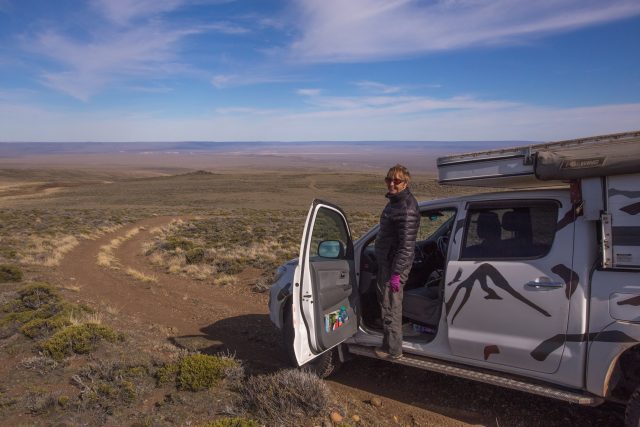 Here Paula is hanging on to the car so she isn’t carried away by the ferocious wind.
Here Paula is hanging on to the car so she isn’t carried away by the ferocious wind.
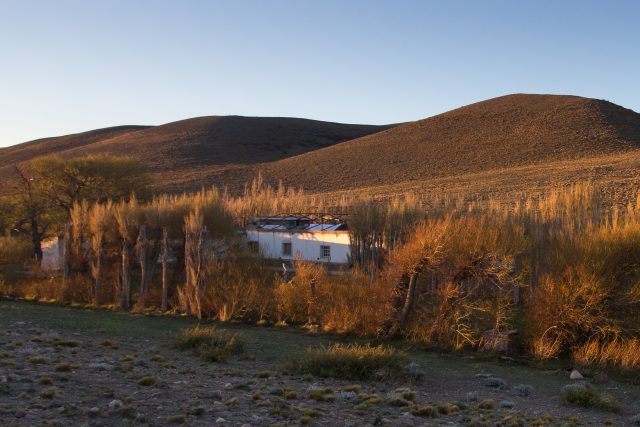 We are staying in a remote biological field station, three hours from the nearest village.
We are staying in a remote biological field station, three hours from the nearest village.
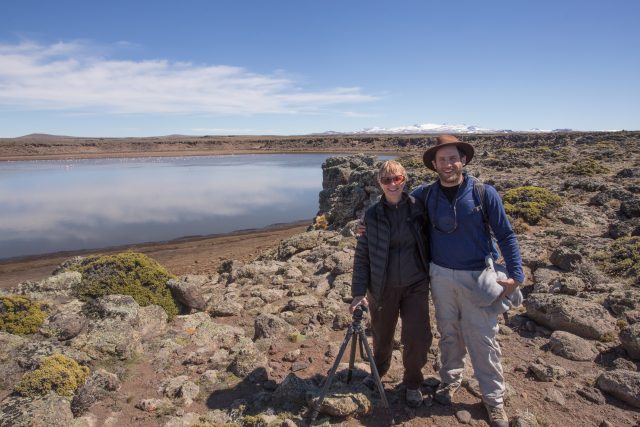 and are working with some great people who are helping us a lot.
and are working with some great people who are helping us a lot.
AND we have seen our first Hooded Grebes, a pair. They were displaying to each other on a lake that was quite low down, not on the high plateaux where they breed.
We watched the pair of birds all afternoon. They were mixed in with Red Shoveler and Silvery Grebes.
The following morning we returned and they were gone.
Hedgehogs are prickly, some people are too. The best three prickly places we’ve been to are all in the coastal desert of Chile and that is perhaps the best place in the world for cacti.
We had never imagined a landscape full of Cacti, but that was before we had set off on the ‘Living Wild in South America’ expeditions. The Americas are the global stronghold for cacti and the map shows the best tree areas to find them.

One of the most prickly places in South America is the Paposo area.
Paposo is a small village on the north coast of Chile, about 50 km north of Taltal and some 200 km south of Antofagasta. Along this coastal strip the Atacama desert reaches down to the sea. Here the stony ground is brushed by the coastal fogs or ‘camanchaca‘ which generates just enough moisture to sustain a splendid floral landscape of cacti.
Some of the more abundant types of cacti are those belonging to the Copiapoa, as can be seen in this picture.
This is Copiapoa cinerea, a rare and vulnerable species.
Paula and I first travelled through this area of Chile in February 2015, shortly afterwards El Nino brought heavy rain and flooding to many places in northern Chile. So we returned in October in the hope of seeing the desert in flower
In October the desert was much greener and some plants were even flowering. It wasn’t the mass of flowers that we expected but it did show us the real effect that rain has on this ‘prickly landscape’.
The Southern Screamer is a real screamer of a bird and found only in South America.
It looks like a goose and its closest living relative is the Australian Magpie goose. This is not surprising as millions of years ago the continents of Australia and South America were joined.
For the nature and wildlife lover the Ibera Marshes in the Corrientes province of Argentina, is a ‘must go ‘ location. As for birds, there are over 300 species and birdwatchers flock to the area to see them.
Southern Screamers have huge feet and can swim well. We found them fairly common in the Ibera Marshes of Argentina.
This image shows a territorial display, the birds love having control of a tree, bush or prominent perch from which they can emit their loud and penetrating call, an emblematic and evocative sound of the marsh a true Screamer of a bird. (Click on Screamer to hear it for yourself!)
Many travel companies operate tours to Ibera. For the specialist wildlife photographer or birdwatcher these tours can be linked to other notable places to visit. Ibera marshes are in the NE of Argentina and so is the internationally famous Iguacu Falls, which is further NE on the border with Brazil. Between the two lie the Atlantic rain forests, one of the most threatened forest environments in the world and full of endemic wildlife. You can fly from Buenos Aires to Posadas and hire a car for yourself or use a local tour company.
The Northern access point to Ibera is from Ituzaingo. This is a delightful town and is the base for Turismo Diversidad , an English speaking tour company which specialises in wildlife and bird tours.
For thousands of years the Andean people relied upon one type of animal as their means of transport. All their goods being transported by this one haughty beast, the Guanaco, which formed the ‘Caravans of the Andes’.
This ungainly and spitting beast took the place of the horse as the continent’s beast of burden.
Over the thousands of years the indigenous peoples of the Andes domesticated the Guanaco into a slightly more amenable and much more useful animal, the Llama.
Whilst the Llama will not allow itself to be ridden it had the capacity and strength to carry goods and for the people living in the high Andes this made the animal valuable. The Incas used the droppings from the Llama and Guanaco to fertilise their crops. ‘Caravans of the Andes’ made up of Llamas would transport potatoes, maize,wool and salt from the Altiplano west to the coast and east to the lower lands, the forests and dry deserts. On their return journeys, the Llamas would carry fish and seafood from the coast or feathers, tobacco,wood and honey from the lowlands in the east.
The entire economy of the Andean peoples relied upon the Llama, whist the milk, meat and wool from the animal directly sustained them in their harsh and mountainous environment.
There is a special place in northern Chile where these ‘caravans’ congregated. It is thought that hundreds of ‘caravans’ would converge on this place particularly at fiesta times. Not only was this a great market it was also a stock exchange of promises and plans. Families would unite, marriages proposed, debts settled and no doubt revenge sought after.

Paula and I were travelling through the Atacama desert. We were returning from an expedition to Peru, part of a ‘Living Wild in South America’ filming and photographic project.
We saw up on the distant hills, patterns and shapes, so we investigated. This was the Salar de Pintados near to Iquique. These patterns could be seen from all directions, signposts in the sky. Thousands of years ago caravans of tradesmen, merchants, families from throughout the Andes may have journeyed here and the animal that would have sustained them would have been their Llamas.
Guinea pigs bigger than dogs ? then welcome to South America where the World’s largest rodent a close relative of the guinea pig is the Capybara.
It is both bigger and, weighing in at 60kg, heavier than most large dogs. So South America has Guinea pigs bigger than dogs.
The Capybara is a vegetarian and lives most of its life in water, so this ‘guinea pig’ is more like a South American ‘hippo’.

The Ibera marshes of NE Argentina are 100 miles long and 60 miles wide.
It is a mosaic of wetlands interspersed with wooded islands and floating plant life.
This is ‘hippo heaven’. The ‘Living Wild in South America’ expedition entered the area and we wanted to find this ‘guinea pig’ type animal and surprisingly had no trouble doing so.
There are few tracks that cross this immense waterscape but even in the remotest parts, Capybara are so numerous they almost become a nuisance.
To pass them, we would have to get out of our truck and herd them to one side.
As for filming them, this was no problem!
It has been over two years since we started our amazing South American expedition.
Check-out this map as it shows where we have been.
Some people can go round the World in two years, we don’t, because we move slowly and because we move slowly, the more we see, the longer we have to talk to people and the easier it is to get good photographs.
We will continue to travel, through blizzards, mud, electric storms and floods, but we love every minute.
We have traveled through the forested Peruvian mountains.
In the Andes we have found many of its special birds like this Hooded Mountain Tanager.
We will continue to visit and encouraged many conservation projects, such as the Jaguar Re-introduction project in Corrientes.
We meet many inspiring people such as Juan working to protect the Yellow Anaconda snake in marshlands of Formosa.
Soon we depart for our fifth expedition, follow our exploits on our website which always shows you where we are.
The roads we take are small. We know they will lead us to unknown places, lovely people and wildlife.
The “Living Wild in South America” expeditions love landscape photography .
We have been working ‘in the field’ for over a year, in Argentina,Chile and Peru.
We have carried our equipment through humid forests, along gale blown cliffs and across hot deserts, but the most inspiring area for landscape photography has been the high Andes.
All these images, except the last, were taken at between 11,000 and 14,000 ft. At such heights where the air is thin, breathing is sometimes difficult. This means that you have to use a tripod as your breathing is so laboured, it causes camera shake. The lack of oxygen means that you have to go slowly, there is no hurrying at that altitude.
The air is usually crystal clear, but the weather is fickle and storms are common.
An inspiring place for a photographer but a really tough and challenging environment.
These six images will trace an imaginary journey from the Argentinian Chaco, over the great Andes mountains and down to the Pacific coast of Chile. All were taken with a Canon D6 camera and 18-55mm lens, always on a tripod and sometimes using a polarizing filter . The images have been developed in Lightroom with hardly any alteration except for the use of black and white sliders and cropping.
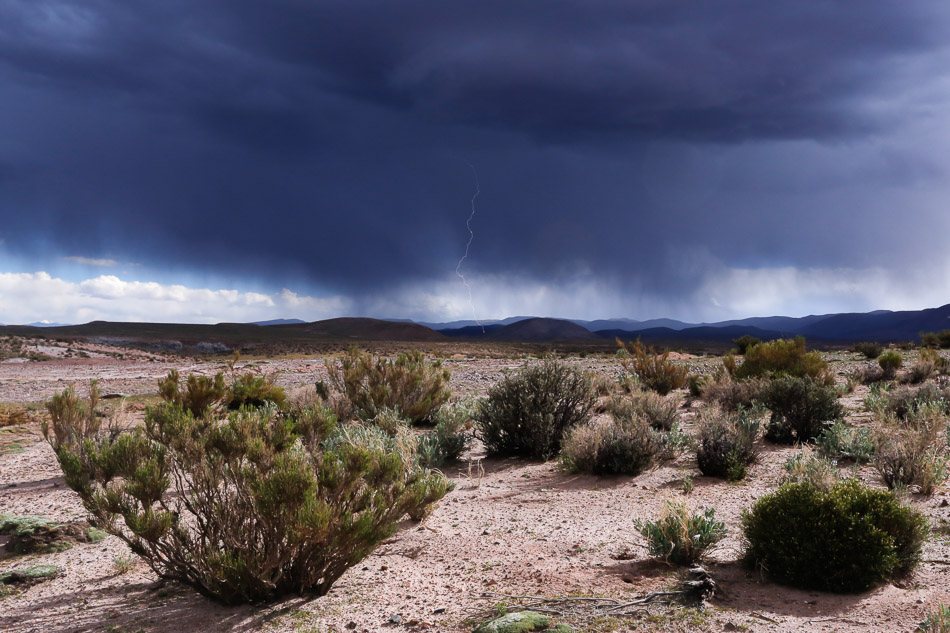
Travelling from Argentina, the foothills rise gradually, winding roads, some only tracks, twist and double back on themselves. Tall cacti are scattered across the thorny scrub and rock, dried up river beds lie sullen, like a serpent waiting to be woken.
The next time you look, the vegetation is much sparser, the cacti have gone and the land is flatter, this is the Puna, the historic and cultural home of the Andean people.
As we set up camp the sky turned ominous, thunderous rumbles echoing through the hills. Storms encircled us and lightning flashed from all directions. That night we got very wet!
Higher still and you reach the Altiplano where there is almost no vegetation. This is a dry, arid land, sculptured by the wind. Two days prior it had snowed and small scatterings of snow were still visible.
We cross over a high Andean pass into Chile. The Andes are one of the most volcanic parts of the planet. We camped close to this spot and early in the morning found a small group of Chilean Flamingos unable to move, as their feet were frozen into thin ice on the lake.
After several hours in my photographic hide, thawing out my own fingers took some time too!
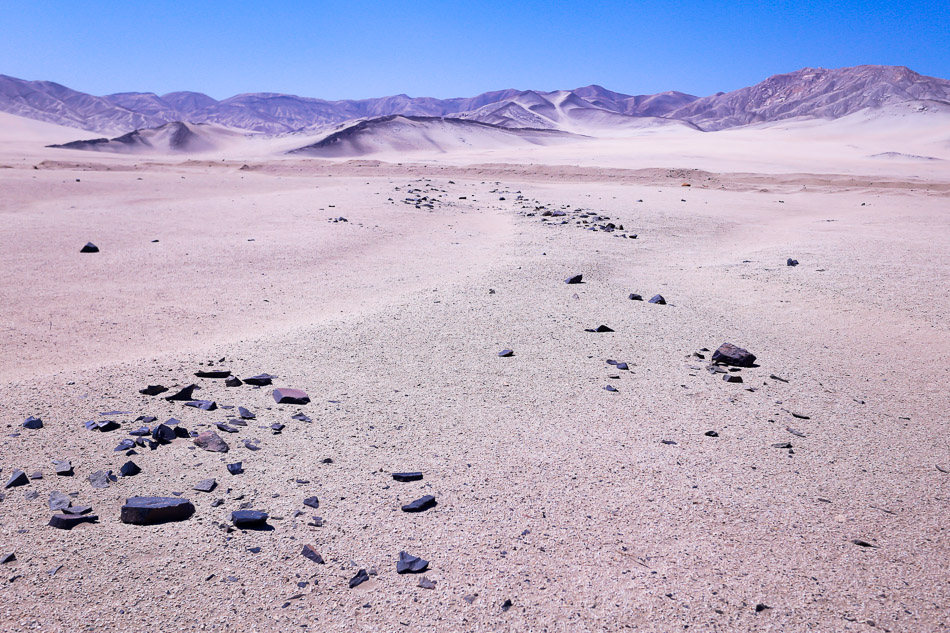
Gradually descending downwards from the Chilean Puna we enter the Atacama desert. At 600 miles long and up to 200 miles wide, the Atacama is the driest place on earth and a dangerous place for the unwary. It is a strange place, which we found difficult to photograph to our satisfaction.
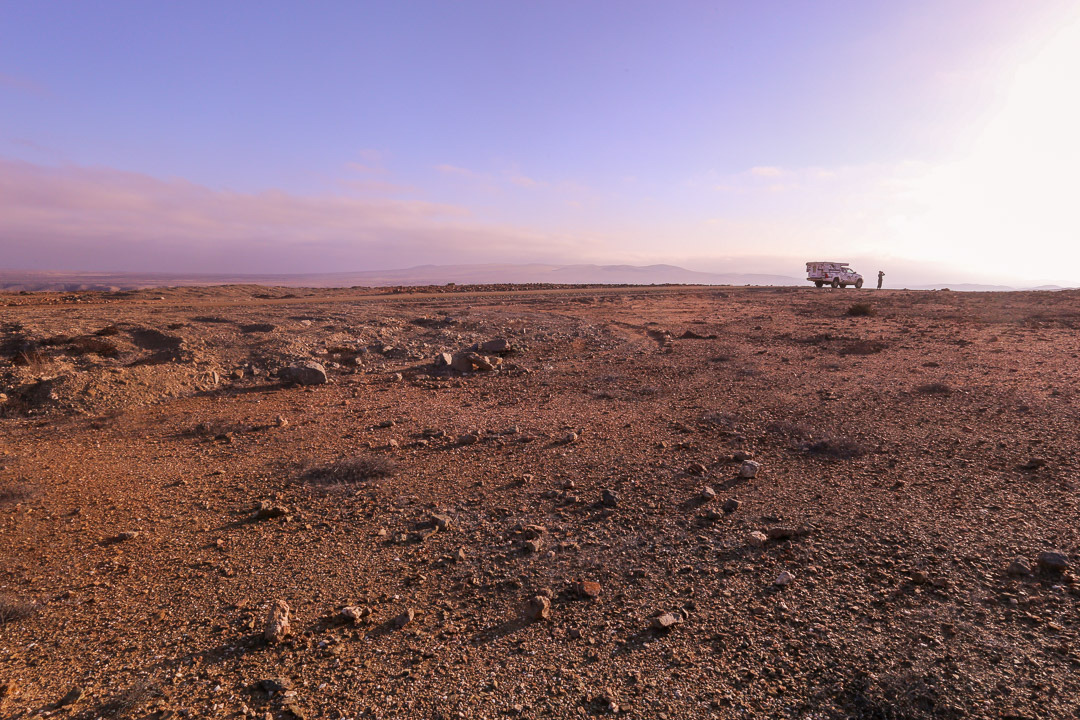
See what I mean? Much of the Atacama is like this, flat, barren, devoid of anything. One afternoon I decided that was exactly what I should photograph, so I walked off and left Paula staring into the distance. This is now one of our favourite photographs, we call it ‘Lost in a landscape’.
Finally we reached the Pacific coast of Chile, where the Atacama desert meets the Pacific Ocean. This coastal desert is a narrow strip of land which receives mist off the Pacific. This unique fog is called the Camanchaca and provides just enough moisture to sustain a sparse but cactus rich vegetation.
These three tips to improve Low Light photography are going to improve your images, irrespective of the equipment you use.
However if you have a full-frame sensor or you shoot in Raw, not jpeg, your results will be even better.
It is also worth remembering that our eyes are far better than our cameras. Our eyes see a much broader range of light, called ‘dynamic range‘.
The term ‘Low Light’ covers a huge range of different situations. My definition here is to say that it means undertaking photography before the sun has risen or after it has set. At these times there is no direct sunlight at all and this is when photography is fun and challenging and can provide you with your VERY BEST shots of the day.
The two problems that confound photographers achieving a good result in conditions of low light are, (a) blurry out of focus images and (b) lots of ‘noise‘ spoiling the overall look of the picture.
Out of focus images are generally not what people want and there is little you can do to correct it. Noisy images are a fact of life in digital photography but there is a lot software available to help you minimize it, in post-production.
Three tips to improve Low Light photography – Tip no 1
Use a tripod. I cannot over-emphasize the importance of this. Using a tripod is a fundamental ‘building block’ of good photography and specially low light work. You don’t have to have a big heavy tripod, any tripod is better than no tripod.
Three tips to improve low light photography – Tip no 2
Set your camera to a high shutter speed and this depends on the lens that is fitted. For instance for a 24mm lens, a shutter speed of at least 1/50th is necessary. For a 300mm lens, a minimum of 1/200th is required. To achieve a higher speed you will have to decrease the aperture, this will allow more light into the camera. So taking the aperture from f 16 to f 5.6 will be a positive improvement.
Three tips to improve low light photography – Tip No 3
Increase your ISO
This is where having a full-frame camera is a big advantage as it has a larger sensor. On a full frame camera you will get good results with an ISO of 2000, whereas on an equivalent crop frame camera at the same speed, the ISO will be no higher than ISO 800. The lower your ISO the lower your speed. A rule of thumb is ‘ doubling the ISO, doubles your speed, but doubles the noise’ a tricky conundrum. The skill comes from knowing what you want to achieve from a photograph and making the appropriate decisions in setting your camera
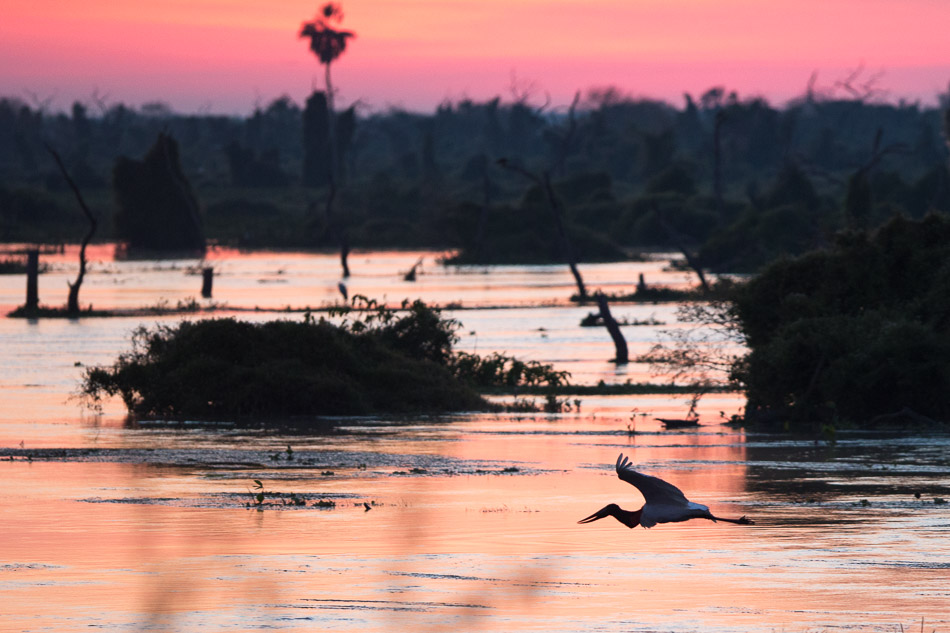
ISO 2000, f3.2, 1/800th sec
In this pre-dawn shot I wasn’t bothered about the out of focus background, inevitable with an f3.2 aperture. I wanted a sharp flying bird, but not too much noise so an ISO of 2000 was not ridiculously high and it gave me a speed that just made it possible to get a good photograph. This combination of settings would not have been successful without a tripod.
Butterflies and smartphones have a lot in common.
We explored a trail, winding through the dark, dense and damp forest. Moss hung from the trees, bromeliads and orchids festooning their trunks and branches. Then we stopped and looked in awe, before us the evergreen leaves were covered with what seemed like a mist, making it difficult for us to focus on what was there. This was no ethereal mist, we were seeing butterflies, millions of butterflies, suspended on every leaf and twig from knee height to tree-top level and the slightest touch on a branch or leaf would send a storm of wings fluttering upwards as they moved position.
On close inspection we found that we could look through their wings. These were the amazing Glasswing butterflies! We didn’t know when they had arrived, we didn’t know why there were so many or what they were doing! These questions we were unable to answer, but often with wildlife, just seeing them was enough. It was a special moment and by the next day not one was to seen, they had vanished as quickly as they had appeared, a rain forest secret.
Paula and I were ‘Living Wild’ in Calilegua National Park in the NW of Argentina. We were there to find birds in the Southern Yungas rainforest, a habitat for which this National Park is famous but instead had found these amazing butterflies.
In a dark temperate rain forest, bright shiny objects are noticed easily. The sunlight that does penetrate the canopy pierces the foliage with spear-like brilliance, reflecting again and again off the waxy green leaves. Butterflies are abundant, black ones with red spots, white ones with blue streaks, every colour combination imaginable.
Evolution pushes experimentation as the genes mutate to trial new ways to survive. Instead of being one of many multi-coloured butterflies, a strategy to experiment with invisibility was worthwhile, for over the millenia this family of butterflies has achieved a cloak of virtual invisibility.
For this invisibility to succeed they needed the membrane of scales that makes a butterfly wing to be non-reflective and accordingly scientists have found that the Glasswing butterfly wing does just that. The wing surface is not only much less reflective than a sheet of clear glass but also has the capability to suppress infrared and ultraviolet light, the two wavelengths most used by birds and amphibians in detecting prey species. Transparent wings are really all about the play of light and shadow, this makes sense as Clearwings usually inhabit the lower parts of tropical forests characterized by alternating shadows and shafts of bright light.
To us the surface of the wing of a Glasswing butterfly is flat and smooth but seen using an electron microscope the surface is a chaos of peaks and troughs. This means light is not reflected back but passes through the surface and refracted. Birds and other predators are confused, they cannot see the insect as it darts and manoeuvres through the forest.
Nano technologists have taken this marvel of nature and incorporated the same technology into the screen of smartphones. So when you are walking down the high street on a sunny day and you can see the messages on your screen so well – thank the Glasswing butterflies for that.

